- Our Mission
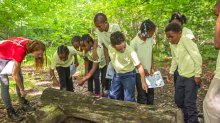

Yes, Field Trips Are Worth the Effort
Culturally enriching trips can boost grades and decrease absences and behavioral infractions, new research reveals.
As a teacher, Elena Aguilar often looked for opportunities to get her students out of the classroom and into different neighborhoods or natural environments. “We did the usual museum trips and science center stuff, but I loved the trips which pushed them into unfamiliar territory,” writes Aguilar , an instructional coach and author. Nudging kids out of their comfort zones, she says, “taught them about others as well as themselves. It helped them see the expansiveness of our world and perhaps inspired them to think about what might be available to them out there.”
Aguilar’s thinking made an impact: 15 years after traveling with her third-grade class to Yosemite National Park, a student contacted Aguilar on Facebook to thank her for the life-changing excursion. “You changed our lives with that trip,” the student wrote. “It's what made me want to be a teacher, to be able to give that same gift to other kids.”
As schools grapple with pandemic-related concerns about balancing in-seat instructional time with non-essentials like trips, new research published in The Journal of Human Resources argues that field trips, and the vital educational experiences that they provide—whether it’s a visit to a local museum or a big commitment like Aguilar’s national park trip—deliver a host of positive social and academic outcomes and are worth the effort.
“The pandemic should not keep schools from providing these essential cultural experiences forever,” asserts Jay P. Greene , one of the study’s co-authors and a senior research fellow at the Heritage Foundation, in an opinion piece for the Daily News . “If schools make culturally-enriching field trips an integral part of the education experience, all students—especially those whose parents have a harder time accessing these experiences on their own—would benefit.”
In the study, researchers assigned more than 1,000 fourth- and fifth-grade students in Atlanta to two groups. One group participated in three to six “culturally-enriching” field trips—visits to an art museum, a live theater performance, and a symphony concert—while students in the control group stayed put in class. The outcome? Kids in the field trip group “scored higher on end-of-grade exams, received higher course grades, were absent less often, and had fewer behavioral infractions,” compared to students in the control group, according to a ScienceDaily brief . Benefits lasted two to three years, Greene writes, and were “most visible when students were in middle school.”
“We are able to demonstrate that a relatively simple intervention—and we consider it pretty low-touch; three field trips in a year, maybe six field trips in two years—can actually have some substantial impacts,” says lead study author Heidi Holmes Erickson in an interview with The 74 . “They’re not just limited to social benefits. It shows that smaller interventions can actually have some significant effects on academics as well.”
Field trips aren’t a threat to in-class instruction, Erickson notes, they’re a tool to help bolster engagement and expand students’ horizons. “It's possible to expose students to a broader world and have a culturally enriching curriculum without sacrificing academic outcomes, and it may actually improve academic outcomes,” Erickson says. Far from harming test scores, the researchers found that culturally rich excursions reinforce academics and “students who participated in these field trips were doing better in class.”
Meanwhile, class trips don't need to be elaborate productions to make an impact: small excursions outside the classroom—"low-touch," as the researchers call them—can pack a punch. Here’s how three educators recommend dialing it back with low-stakes options that are both engaging and stimulating for students, but might not require days to prepare and plan:
Make Them Bite-Sized : Instead of allocating an entire day to a field trip, educational consultant Laurel Schwartz takes her classes on micro field trips , or “short outings that can be completed in a single class period.” These real-world encounters, she says, are especially beneficial for English learners and world language students. A micro field trip to a nearby park or around school grounds, for example, can be a great opportunity to “enhance a unit on nature and wildlife while reinforcing vocabulary for senses, colors, and the concepts of quantity and size,” Schwartz writes. “Afterwards, students might write descriptive stories set in the place you visited using vocabulary collected and defined together by the class.”
Try Teacher-Less Trips : To encourage exploration and learning outside of the classroom, former social studies teacher Arch Grieve removes himself from the equation with teacher-less field trips rooted in students’ local communities. Grieve only suggests options that are directly tied to a unit being discussed in class—like attending a talk at a local university or visiting a museum or cultural festival—and offers extra credit to incentivize students. “These trips allow for a greater appreciation of my subject matter than is possible in the school setting, and perhaps best of all, there's little to no planning involved.”
Explore Virtual Options : It may not be as fun as visiting in person, but the Internet makes it possible to visit museums like The National Gallery of London and The Vatican Museums without leaving the school building. Middle school English teacher Laura Bradley likes to search the Museums for Digital Learning website by topic, keyword, and grade level, to find lessons and activities that meet her unique curricular needs. The site grants access to digitized museum collections, 3D models, audio files, documents, images, and videos.
- Go School Trip - Make Better Tomorrow

- Search for:
- Vietnam School Trips
- Cambodia School Trips
- Laos School Trips
- Myanmar School Trips
- Thailand School Trips
- Indonesia School Trips
- Japan School Trips
- Singapore School Trips
- China School Trips
School Trip Blog
What is field trip | definition of field trip in education.
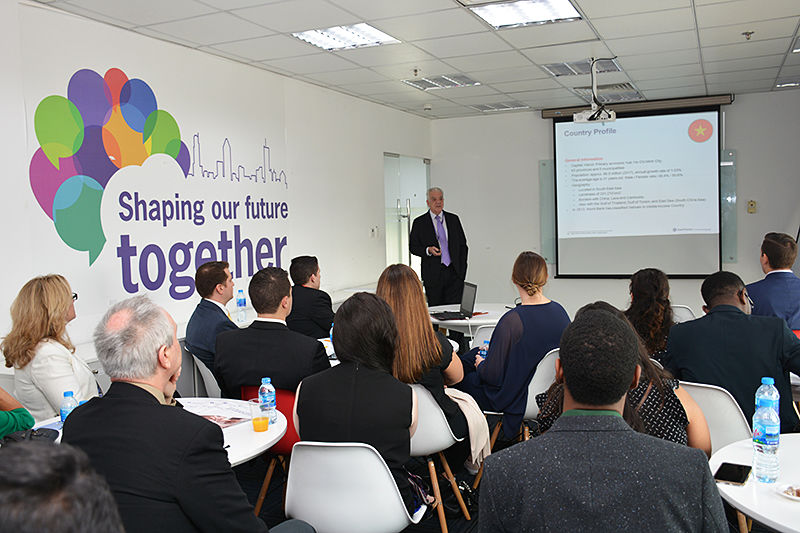
The term “field trip” has been known for decades in many sectors and it is a common term used in worldwide schools. It seems that a field trip is a favorite part of both teachers and students who are keen on learning and discovering. So, what is a field trip in education? Scroll down to find out the field trip definition and its many types.
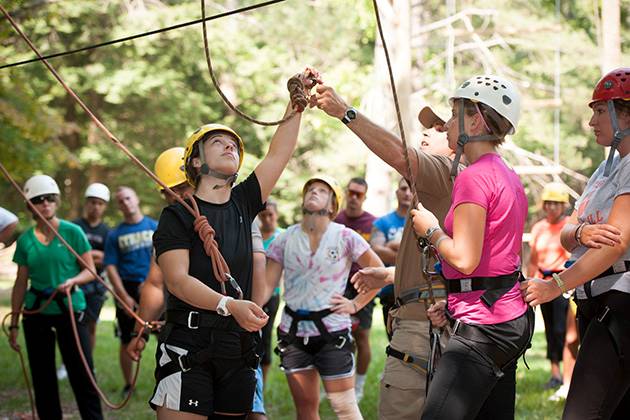
Educational Field Trip Definition
A field trip or excursion is a journey taken by a group of people to a place away from their usual environment. In education, field trips are defined as visits to an outside area of the normal classroom and made by a teacher and students for purposes of firsthand observation. A field trip can be expressed in many terminologies. People call educational trips or school tours in the UK and New Zealand, and school tours in the Philippines. Field trips are a popular method carried out for students to introduce to the concepts, experiences, and ideas that cannot be given in a classroom environment. School tours can be considered as short-term learning activities providing students the opportunity to observe their chosen subject outside of a classroom setting. Exploring other cultures and customs, getting to the motherland of languages, uncovering pristine nature and experiencing fascinating local life are striking demonstrations of educational school trips
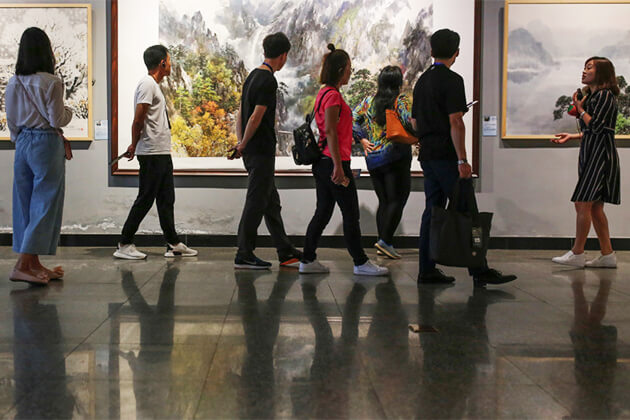
Types of Field Trips
Those listed field trip ideas that help to clear field trip meaning. Efficient educational tours can spark students’ imagination, give them valuable experiences and refresh their minds after days with pencils and papers. A school tour can be themed with one type of field trip or combined by various school trip ideas.
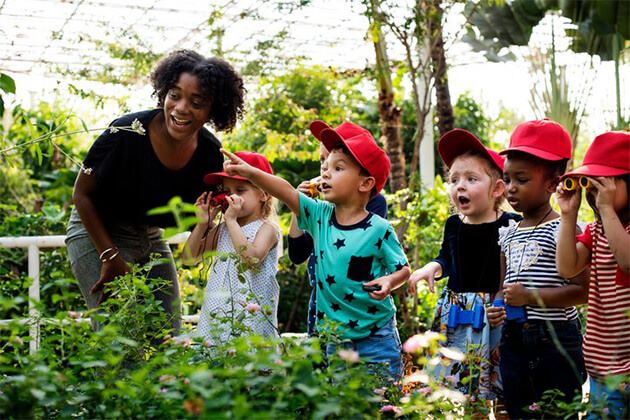
Sightseeing Field Trip
Students are definitely eager the most to sightseeing school trips enchanting them by a myriad of appealing attractions in their wish destination. Admire well-known attractions, explore historic structures, discover World Heritage Sites, unwind on spectacular landscapes and freshen in front of scenic vista are incredible activities that gain huge interests from students and strongly inspire them.
Language and Culture Educational Field Trip
For students learning foreign languages, field trips are very important and helpful to improve the language and explore the alluring indigenous culture. Join immersive activities, stay at a local homestay, take language lessons and visit local markets enable students to practice the language, get a deeper understanding of local culture and their captivating paces of life.
Gardening and Farming Field Trip
This might be an interesting activity attracts lots of students’ attention thanks to its strangeness to their usual life. Discover specialty farms that grow the normal crop and even irregular crops will surprise curious students. Learn how vegetables are produced, explore and give a try to do traditional farming techniques of local people leaves memorable experiences for students.
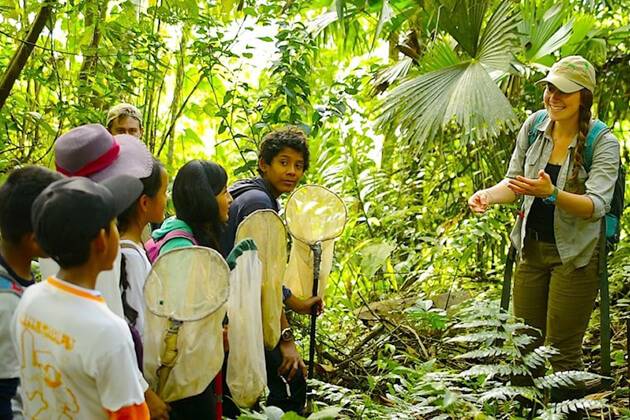
Manufacturing Facility Field Trip
Students can be guided to any factory where equipment, cars, tools, packaging or any other things are made. The mechanized facilities and assembly lines are interesting for students to learn about the production process, how raw materials are utilized and how workers use them to make the final product.
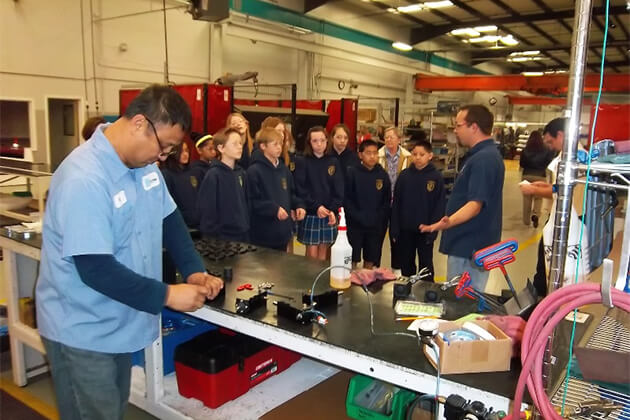
Eco-adventure Field Trip
Discover the natural world is a highly important perspective in the educational sector. Students can be entertained and refreshed by trekking through untouched natural beauties to inspect local plant life and wildlife animals. This opportunity also adds to local historical factors such as early life remnants.
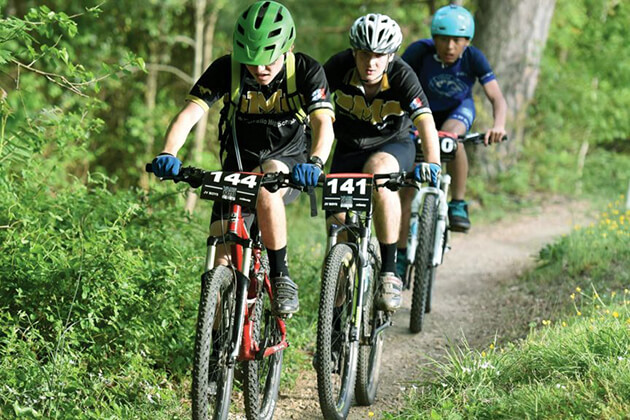
Business Educational Tour
Take business study trips, your students will be delighted by bustling financial and business centers. Business study trips help process business theories in the classroom into life as students explore great commercial organizations. Business field trip gives students the chance to immerse in stimulating and dynamic environments. Visit a range of famed organizations and large corporations will perfect business school trips.

Username or email address *
Password *
Remember me Log in
Lost your password?
Field Trips: Pros and Cons
Off-campus excursions can enhance learning, but they pose challenges
- Tips & Strategies
- An Introduction to Teaching
- Policies & Discipline
- Community Involvement
- School Administration
- Technology in the Classroom
- Teaching Adult Learners
- Issues In Education
- Teaching Resources
- Becoming A Teacher
- Assessments & Tests
- Elementary Education
- Secondary Education
- Special Education
- Homeschooling
- M.Ed., Curriculum and Instruction, University of Florida
- B.A., History, University of Florida
Are field trips worth all the time and effort required to make them successful? Most teachers have asked themselves this question at one time or another, typically when feeling overwhelmed as they prepare for a field trip. The truth is that field trips at any grade level can cause quite a few headaches for teachers. At the same time, well-planned field trips can provide students with truly educational experiences they cannot get in the confines of the classroom. Following is a look at the pros and cons of field trips.
Benefits of Field Trips
Field trips provide students with new opportunities for learning through experience:
Different Learning Modalities
Information is presented to students in a way that meets different learning modalities. Field trips provide students with the ability to learn by doing instead of just passively listening to the information being taught in class.
Students are exposed to new experiences that, hopefully, broaden their horizons. This can be especially helpful for students from lower socioeconomic backgrounds who may not have been exposed to these opportunities before.
Reinforcing Concepts
Concepts that have already been learned in the classroom can be reinforced. Sometimes seeing information being taught in a new way can make a big difference in student comprehension. There is quite a difference between being taught about something like hurricanes and wind speed and experiencing them in an exhibit at a science museum.
Shared Reference
Students are provided with shared reference points that teachers can then refer to and use in future lessons. There may be an opportunity to have two or more disciplines use a field trip as an enrichment activity. For example, a trip to an art museum (art) may couple with a timeline for social studies (political systems in place when art was created) or math (measurements) can combine with science in a biosystem (river, beach, and meadow). In this manner, several teachers can then refer to things that students saw and experienced during the field trip for the remainder of the school year.
Increased Student-Teacher Communication
Students and teachers can see each other in a different light, helping to increase communication between them. Some students who might be overlooked in class because they are quiet might really come alive on field trips.
If parents are involved as chaperones, they can feel more connected to the teacher and the lessons being taught. They can get to know the teacher better and understand what teachers deal with daily.
Meeting Standards
Standards in social studies and science require students to have experiences related to concepts in the discipline. In social studies, students are required to take informed action. In science, students need to be exposed to a series of concepts to help them to better understand the world around them. Field trips help teachers meet these objectives.
Problems With Field Trips
Teachers face a number of concerns and challenges when designing field trips that they need to recognize and address before planning a field trip.
Preparation Needed
Field trips take preparation if teachers want to make them meaningful. They have to coordinate locations and transportation. They also need to create an effective lesson plan that they will follow when on the excursion.
Students will be out of the school building for a field trip, which means they will miss other classes—at least in middle and high school. If each core subject area (ELA, math science, or social studies) offers one field trip during a school year, students would be out of the building for four days. School attendance policies may count these as excused absences, but any field trip that removes students from class reduces the number of classroom hours.
Trips Can Be Costly
Field trips can be expensive, and some students may not have the funds to attend. Organizers of the field trip may consider asking for parents to add a few dollars to help students in need. School boosters may need to host a fundraiser for students to raise money for more expensive trips.
Teachers have to organize the collection of money and the assigning of chaperones. Teachers need to spend some time creating student groups that work for all students and ensuring that chaperones are assigned accordingly.
Teachers will likely have to deal with red tape as they plan field trips including permission slips, medical information, and emergency procedures. Schools typically require paperwork from teachers and their students.
Potential Discipline Problems
Students will be placed in a larger environment than the classroom. New surroundings could possibly lead to additional discipline problems. Because teachers typically only lead a small group (such as 30 to 40 students), they may not be able to maintain control over the behavior of every student on the field trip, especially if the group is large. Teachers should go over rules and expectations before the field trip, enforce the rules strictly while away from school grounds, and create effective consequences for misbehavior.
May Be Disappointing
The field trip destination might not live up to the teacher's expectations. The location might not be as interesting as the teacher thought it would be. The time to complete the field trip might be considerably less than was expected. Therefore, it is a good idea to have some contingency plan in mind just in case.
There may be students who, for one reason or another, will not attend the field trip. Teachers must leave lessons, usually enrichment offerings, that mirror some of the concepts being experienced on the field trip.
Requesting Feedback
One of the best ways to measure the success of a field trip (other than returning all students back to the school) is to ask for feedback. Teachers can post a survey for participants and for other chaperones asking them to express how they would evaluate the trip.
Opportunity to Reflect
Students should have the opportunity to reflect on the trip and write a response in a journal or essay. Requiring journal responses after the trip can solidify the information learned as students reflect on their new experiences. Asking students to write a thank you to the school principal for allowing the trip may even smooth the path to additional field trips.
Worth the Difficulties
Many teachers feel that well-chosen field trip destinations are worth the difficulties they may create. The key is taking the time to plan each aspect as much as possible. Teachers should be proactive when thinking about and planning field trips. Students, on the other hand, may remember the experience of the school field trip as a highlight of the school year, and the time they learned more than anything taught in class.
- How to Have a Safe, Fun, and Successful Field Trip
- Pros and Cons of Teaching
- The Pros and Cons of Block Schedules
- What Are Some Pros and Cons of the Common Core State Standards?
- Pros and Cons to Flexible Grouping in Middle and High School
- Whole Group Discussion Pros and Cons
- Parents Guide to the Pros and Cons of Homeschooling
- Job Sharing for Teachers
- How Scaffolding Instruction Can Improve Comprehension
- How to Avoid Common Mistakes When Writing Learning Objectives
- 7 Back to School Tips for Teachers
- 11 Pros and Cons of Using Movies in Class
- 10 Pros and Cons of Being a School Principal
- 7 Ways to Take Control of Your Classroom to Reduce Student Misbehavior
- Methods for Presenting Subject Matter
- Advantages and Disadvantages of Lecturing

Is There a Difference Between a Field Trip and an Educational Tour?
There is nothing more exhilarating for most students than hearing the news of an upcoming school trip. It gives students a reason to get out of the classroom, and educators a way to teach and connect with their students on another level. But what kind of trip should you take your students on – a field trip or an educational tour – and is there a difference?
While it might just be an issue of semantics for some people, there is an important difference between field trips and educational tours, particularly those organized by Junior Tours .
Field trips are the typical school trips that most schools plan for their students, lasting anywhere from a few hours to 1-2 days while visiting certain learning sites.
Educational tours are professionally planned tours that have been finely crafted based on the needs of the entire group.
Essentially, an educational tour is an enhanced and upgraded version of the traditional field trip.
While the difference between a field trip and an educational tour may seem unimportant, there are many ways that a professional tour organizer such as Junior Tours can enhance the learning and overall experience of any trip, making it well worth the time and money of every student involved.
Educational Tour VS Field Trip: What’s the Difference?
We’ve all been on field trips, whether as students or educators, and we know the typical expectations that come with school trips. Typical school field trips include:
- The local museum for sciences or arts
- A visiting play or musical performance
- A local university or research center, with an expert or professional
While children always enjoy getting out of the classroom and experiencing something new, it can be difficult to truly engage with the entire group at all times. In many cases, school field trips end up with most students goofing around, not listening to the tour guide, or getting in trouble in unique ways.
And it isn’t always fair to educators to expect them to plan and execute the perfect field trip, as these skills aren’t in their everyday job description. Teaching a classroom of students and implementing a successful field trip are worlds apart.
An educational tour is like a field trip, but handled professionally and every aspect made perfect. With an educational tour planned by professional organizers, schools and teachers can focus on their roles – teaching – while the organizers focus on everything else that children want from a school trip – exciting destinations, interesting guides, awesome activities, effective planning for every step of the trip, and so much more.
Many schools do not realize how much value a professional educational tour organizer can add to a school trip, turning it from just another trip to something that will act as a key part of every school year.
Here are just a few of the places you might visit during an educational tour with Junior Tours:
- Notre Dame Basilica in Montreal
- The Plains of Abraham in Quebec City
- Concerts, performances, and music festivals in North America and Europe
- Rockefeller Center in New York City
- Niagara Falls
- Improv Chicago
- Centennial Olympic Park in Atlanta
- Shakespeare’s Globe Theatre in London
And so many more. Whether for the sciences, business, culture, or the arts, no two educational tours are exactly alike, as each trip is planned with your group’s needs and expectations in mind.
What Can You Expect from an Educational Tour?
How exactly does a Junior Tours educational tour differentiate from a typical school field trip and what can you expect from it? A tour planned by our veteran tour organizers shares the same objectives as typical field trips, but then we do so much more:
Educational tours offer the full experience for students and educators who are looking for something more than just the average community school trip. With our tour, groups can pick their journey based on their subject interest, with popular choices of:
- Music & Band
- Foreign Language
- African American
You can see that the difference between a field trip and an educational tour can be found at the most foundational level: the purpose for the trip, and the direction you build from there. With typical field trips, most schools will pick a local area of interest and try to explain a reason for how students can benefit from visiting it.
With professionally organized educational tours, the organizer and the school will discuss and pinpoint the desired learning experience, and then curate a trip around it to maximize what the students can learn. This means that we focus on enriching a student community with education-focused events, rather than building it the other way around.
How Students and Educators Benefit from Educational Tours Over Field Trips
Students – As a student or parent who might be interested in attending one of our educational tours, you might be looking to see how you or your child will most benefit from this journey. Here’s what you can expect as a student:
Out-of-Classroom Learning: Students will see how to truly learn in context, taking their learning out of the classroom and into the real world. They will see the purpose of what they are learning, and its impact on and how it works in the world.
Social Education Habits: Students will develop social education habits that they can carry with them beyond the classroom and their high school or university lives.
Maximum Engagement: Students will enjoy a trip that is curated to maximize their engagement, excitement, and learning, teaching that learning can be fun 24/7.
Educators and Schools: As an educator or school administrator, you might be interested in the tour but don’t know if our terms are worth the additional planning over a traditional field trip. Here are ways our planning and expertise can help you:
Your Choice of Involvement: A fully planned and organized trip. It is up to the school or educator to decide how much involvement they want with the planning and organizing of the trip; if they would like Junior Tours to handle every part of the itinerary, or if they want to be involved in crafting the perfect tour. We report to you and work on your terms.
As Easy as Possible: We make it as easy as possible to help get all your students and parents on board with the tour – we offer free promotional materials such as posters, flyers, and registration forms; professionally trained tour escorts to help hype up the tour 24 hours a day; complete planning of transportation, food, and first-rate hotel stays; and optional direct billing for your parents to pay directly online. And of course, no hidden costs are involved, with free scratch card fundraiser and scholarship suggestions if necessary.
Absolute Flexibility: We offer absolute flexibility with virtually every aspect of the trip. We only require a minimum group size of 20, while larger groups are gifted cheaper pricing. Trips don’t have to be approved by school boards or affiliated with any school, and travel dates can be picked at any time of the year. Whether this is your first time or tenth time organizing a trip for students, don’t sweat it: we can help you with everything.
The Educational Tour Experience with Junior Tours
Ready to start planning an educational tour to share to your group of students? You can start today – just fill in your information on our request form and we will send you over a free itemized price quote and itinerary within 72 hours. Our required information for now includes:
- Potential destinations
- Type of group
- Mode of transportation
- Number of days
- Approximate travel date
- Estimated group size
- Goals for your trip
- School or group name and address
Based in New Jersey, Junior Tours has been helping schools and student groups tour around the country and the wider world since 1967, and we pride ourselves on our history and tradition as a family-run business with an impeccable reputation. Students and teachers who travel with us are guaranteed to have an amazing time – just read our reviews.
Have a question, need some tips? Contact us through our site or call us at 1-800-631-2241 (for group leaders) or 1-800-237-4797 (for students and parents) and let us know how Junior Tours can help your school or community today!
Company Information
- Request a Tour Quote
Tour Packages
- Montreal & Quebec City
- New Orleans
- New York City
- Philadelphia
- Toronto / Niagara Falls
- Washington D.C.
- Williamsburg
Comments are closed.
FOR GROUP LEADERS
For students / parents.
Call (800) 237-4797 Email Us (click) My Account Journal
MAILING ADDRESS
© 2024 JUNIOR TOURS. PRIVACY POLICY
- Professional Affiliations
- The Junior Tours Promise
- Request Quote
- Tour Inclusions
- All Destinations
- Booking FAQ
- Toronto & Niagara Falls
- Online Billing
- Letter of Recommendation
- Fundraising / Scholarships
- Rules & Regulations
- Room List Form
- TSA Travel Tips
- About Junior Tours
- Packing List
- Register for a Tour
- Log In to My Account
- REQUEST QUOTE
REQUEST A STUDENT TOUR QUOTE
Please call 1-800-631-2241 and we can provide you all the information to plan an amazing trip for your students. Or spend two minutes completing this form and we’ll email you an itemized price quote and itinerary within 72 hours.
Tour Information
- Colonial Williamsburg
- Montreal / Quebec City
- Type of Group Please select one from drop down Art Band/Choir/Orchestra Business Drama Family Consumer Science FBLA or Deca Group Foreign Language History Honor Society / Beta Club Senior Class Other
- Please describe your group
- Mode of Transportation Please select one from drop down Motorcoach Air Train
- Number of Days Please select one from drop down 2 3 4 5 8 (London only)
- Approximate Travel Date (the week of...) MM slash DD slash YYYY
- Estimated Group Size Note: Lowest tour fares are based on groups of 40+ Please select one from drop down Less than 20 20-29 30-39 40-55 55+
- Briefly describe your goals for the trip
School / Group Information
- School / Group Name *
- Mailing Address * Street Address City Alabama Alaska American Samoa Arizona Arkansas California Colorado Connecticut Delaware District of Columbia Florida Georgia Guam Hawaii Idaho Illinois Indiana Iowa Kansas Kentucky Louisiana Maine Maryland Massachusetts Michigan Minnesota Mississippi Missouri Montana Nebraska Nevada New Hampshire New Jersey New Mexico New York North Carolina North Dakota Northern Mariana Islands Ohio Oklahoma Oregon Pennsylvania Puerto Rico Rhode Island South Carolina South Dakota Tennessee Texas Utah U.S. Virgin Islands Vermont Virginia Washington West Virginia Wisconsin Wyoming Armed Forces Americas Armed Forces Europe Armed Forces Pacific State ZIP Code
- Home Address
- School Address
Personal Information
- Name * First Last
- Title Please select one from drop down H.S. Teacher M.S. Teacher E.S. Teacher Principal/VP/Admin Parent Student Other
- How are you associated with the tour?
- Mobile Phone *
- Primary Email *
- Secondary Email (optional)
Referral Information
- How did your hear about us? Please select one from drop down Google Received a postcard or mailer Referred by a friend or colleague Met at a convention DECA Postcard FBLA handbook Traveled with Junior Tours before. Received an Email from Junior Tours Other
- For your FREE Gift Please specify the Mail Code on back of catalog mailed to you
- Friend or Colleague's Name First Last
- What did you search for?
- What convention?
- Nice! Where did you hear about us?
- Phone This field is for validation purposes and should be left unchanged.
The Enlightened Mindset
Exploring the World of Knowledge and Understanding
Welcome to the world's first fully AI generated website!
What is a Field Trip: Exploring the Benefits, Challenges, and Creative Ideas
By Happy Sharer

Introduction: What is a Field Trip?
A field trip is an educational excursion outside of the classroom environment. It is an opportunity for students to gain first-hand experience with the material they are learning in class. Field trips can take place at local attractions, museums, historic sites, nature centers, and more. They can also be conducted virtually, allowing students to explore faraway places without ever leaving the classroom.
Overview of Field Trips: Exploring the Benefits and Challenges
Field trips are an important part of any school curriculum. They provide an opportunity for students to gain real-world experience with the material they are learning in class. However, there are both benefits and challenges associated with field trips that must be considered before planning one.
Benefits of Field Trips
The most obvious benefit of field trips is that they give students the chance to experience the material they are learning in class in a real-world setting. According to a study conducted by the National Education Association, “Field trips provide students with experiences that cannot be replicated in the classroom. They offer opportunities to explore concepts from a different perspective, to observe firsthand what has been read about in textbooks, and to make connections between course content and real life.”
In addition to providing an opportunity for experiential learning, field trips can also help to engage student interest in the subject matter. A study conducted by the University of Texas found that students who went on field trips were more likely to remember the material they had learned than those who did not go on the trip. Furthermore, field trips can spark curiosity and inspire students to ask questions and seek out further knowledge.
Challenges of Field Trips
Despite their many benefits, field trips can present some challenges. One of the biggest challenges associated with field trips is the cost. Depending on where you are traveling and the size of your group, the expenses can quickly add up. Additionally, finding the time to plan and execute a successful field trip can be difficult for teachers who already have a full schedule.
Safety is another issue that must be taken into consideration when planning a field trip. It is important to ensure that all students are supervised at all times and that the destination is appropriate for the age and maturity level of the students.
Tips for Planning a Successful Field Trip
Planning a successful field trip requires careful consideration of multiple factors. Here are some tips to keep in mind when planning a field trip.
Establish Goals
Before planning a field trip, it is important to establish clear goals. Ask yourself why you are taking the students on the trip and what you hope to accomplish. This will help to ensure that the field trip is meaningful and relevant to the material being taught in class.
Choose an Appropriate Destination
Once you have established your goals, it is important to choose a destination that is appropriate for the age and maturity level of the students. When selecting a location, consider the interests and abilities of the students and make sure that the destination offers something that will be interesting and engaging for them.
Develop an Itinerary
Once you have selected a destination, it is important to develop an itinerary that outlines the activities for the day. Make sure there is enough time for each activity and that the activities are relevant to the goals you have established for the trip.
Manage Safety Issues
Safety should always be a top priority when planning a field trip. Make sure that all students are supervised at all times and that the destination is appropriate for the age and maturity level of the students. Additionally, be sure to review any safety policies or procedures with the students prior to the trip.
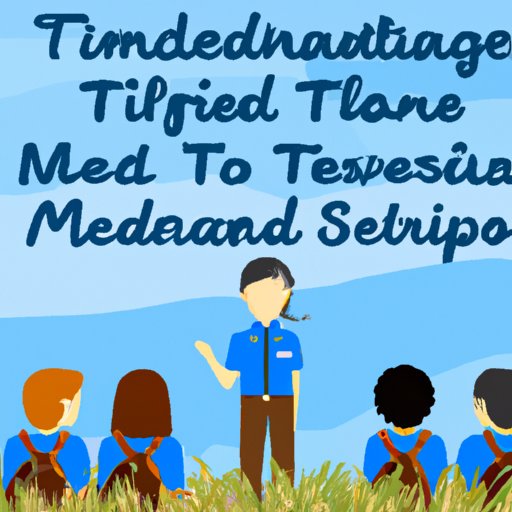
A Guide to Creating a Meaningful Field Trip Experience
Creating a meaningful field trip experience requires careful planning and preparation. Here are some tips to ensure that your students get the most out of their field trip.
Set Clear Expectations
Prior to the field trip, it is important to set clear expectations for the students. Explain to them the purpose of the trip and what you hope they will gain from the experience. Additionally, discuss any rules or guidelines that need to be followed during the trip.
Make Connections with Course Material
When planning the activities for the field trip, look for ways to connect the material to the course content. This will help to ensure that the students gain a deeper understanding of the material and that the trip is meaningful and relevant.
Utilize Time Wisely
Time management is key to ensuring a successful field trip. Make sure that all activities are planned in advance and that the students understand what is expected of them. Additionally, leave room for flexibility in case something unexpected arises.
How Field Trips Enhance Learning in the Classroom
Field trips can be an invaluable tool for enhancing learning in the classroom. Here are some of the ways that field trips can benefit students.
Engaging Student Interest
Field trips can help to engage student interest in the subject matter. Experiencing the material firsthand can make it easier for students to understand and relate to the material being taught in class.
Building Critical Thinking Skills
Field trips can also help to build critical thinking skills. Students are exposed to new information and must process it in order to gain a better understanding of the material. This helps to develop problem-solving abilities and encourages students to think more deeply about the material.
Developing Problem-Solving Abilities
Field trips can also help to develop problem-solving abilities. Students are exposed to new environments and must find ways to navigate them. This helps to build confidence and teaches students how to think on their feet.
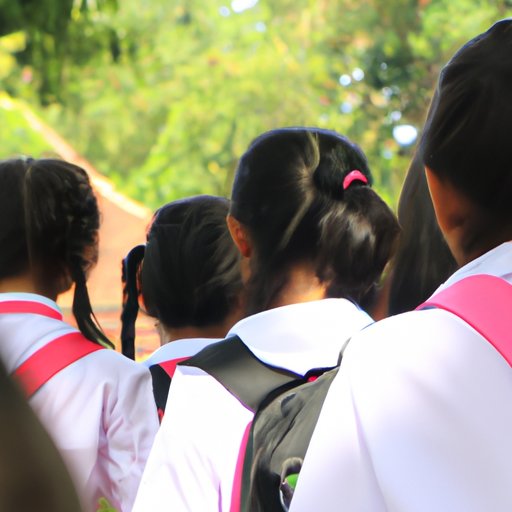
The Value of Field Trips for Students
Field trips can be a valuable learning experience for students. Here are some of the ways that field trips can benefit students.
Developing Self-Confidence
Field trips can help to boost self-confidence. Being in unfamiliar surroundings can be intimidating, but it can also be a great opportunity for students to practice problem-solving skills and develop self-confidence.
Strengthening Interpersonal Relationships
Field trips can also help to strengthen interpersonal relationships among students. Working together to navigate new environments and solve problems can help to foster teamwork and collaboration.
Acquiring New Knowledge and Experiences
Finally, field trips can open students up to new knowledge and experiences. Seeing things firsthand can help to bring the material to life and make it easier for students to understand and remember.
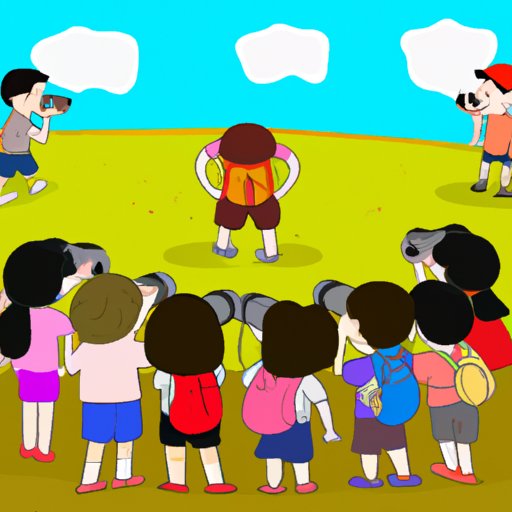
Creative Ideas for Field Trips
There are many creative ways to incorporate field trips into the classroom. Here are some ideas for fun and engaging field trips.
Museum Visits
Museums are a great way to introduce students to a variety of topics. From art and history to science and technology, there are a variety of museums that offer educational experiences for students of all ages.
Local Attractions
Local attractions can be a great way to introduce students to the community and its culture. Consider visiting historical sites, parks, zoos, or aquariums for an interactive and fun learning experience.
Nature Walks
Nature walks are a great way to get students outdoors and exploring their natural surroundings. Not only can this be a fun activity, but it can also be a great way to introduce students to concepts such as ecology and conservation.
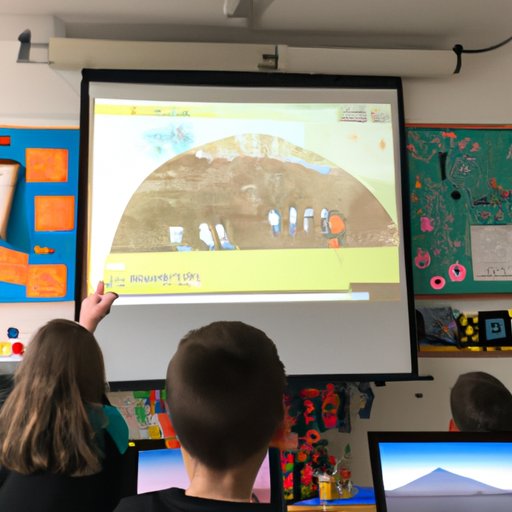
Virtual Field Trips: Taking Education Beyond the Classroom
Technology has opened up a world of possibilities for educators looking to take their students on field trips. Virtual field trips allow students to explore faraway places without ever leaving the classroom.
Advantages of Virtual Field Trips
Virtual field trips come with a number of advantages. They are often less expensive than traditional field trips, and they can be used to explore destinations that would otherwise be inaccessible. Additionally, virtual field trips can be tailored to fit the curriculum and the specific needs of the students.
Types of Virtual Field Trips
There are a variety of types of virtual field trips available. These include virtual tours of museums and historical sites, live video streams of events, and interactive simulations of different environments. Each type of virtual field trip offers a unique experience and can be used to enhance learning in the classroom.
Tips for Planning a Virtual Field Trip
When planning a virtual field trip, it is important to do your research. Check to see if the destination offers a virtual tour and make sure that the technology needed is available and easy to use. Additionally, make sure to set clear expectations and goals for the virtual field trip and to create an itinerary that outlines the activities for the day.
Field trips can be a valuable learning experience for students. They provide an opportunity for students to gain first-hand experience with the material they are learning in class and can help to engage student interest in the subject matter. Additionally, field trips can help to build critical thinking skills and develop problem-solving abilities. Finally, virtual field trips offer an exciting way to explore faraway places without ever leaving the classroom. With careful planning and preparation, field trips can be a fun and educational experience for everyone involved.
(Note: Is this article not meeting your expectations? Do you have knowledge or insights to share? Unlock new opportunities and expand your reach by joining our authors team. Click Registration to join us and share your expertise with our readers.)
Hi, I'm Happy Sharer and I love sharing interesting and useful knowledge with others. I have a passion for learning and enjoy explaining complex concepts in a simple way.
Related Post
Exploring japan: a comprehensive guide for your memorable journey, your ultimate guide to packing for a perfect trip to hawaii, the ultimate packing checklist: essentials for a week-long work trip, leave a reply cancel reply.
Your email address will not be published. Required fields are marked *
Expert Guide: Removing Gel Nail Polish at Home Safely
Trading crypto in bull and bear markets: a comprehensive examination of the differences, making croatia travel arrangements, make their day extra special: celebrate with a customized cake.

- The Journal
- Vol. 14, No. 1
The Educational Value of Field Trips
Jay P. Greene
Brian Kisida
Daniel H. Bowen
Jay P. Greene joined EdNext Editor-in-chief Marty West to discuss the benefits of field trips, including how seeing live theater is a more enriching experience to students, on the EdNext podcast .

Crystal Bridges; Crystal Bridges Museum of American Art; School Tour © 2013 Stephen Ironside/Ironside Photography Bo Bartlett – “The Box” – 2002 • Oil on Linen • 82 x 100 – Photographer is Karen Mauch
The school field trip has a long history in American public education. For decades, students have piled into yellow buses to visit a variety of cultural institutions, including art, natural history, and science museums, as well as theaters, zoos, and historical sites. Schools gladly endured the expense and disruption of providing field trips because they saw these experiences as central to their educational mission: schools exist not only to provide economically useful skills in numeracy and literacy, but also to produce civilized young men and women who would appreciate the arts and culture. More-advantaged families may take their children to these cultural institutions outside of school hours, but less-advantaged students are less likely to have these experiences if schools do not provide them. With field trips, public schools viewed themselves as the great equalizer in terms of access to our cultural heritage.
Today, culturally enriching field trips are in decline. Museums across the country report a steep drop in school tours. For example, the Field Museum in Chicago at one time welcomed more than 300,000 students every year. Recently the number is below 200,000. Between 2002 and 2007, Cincinnati arts organizations saw a 30 percent decrease in student attendance. A survey by the American Association of School Administrators found that more than half of schools eliminated planned field trips in 2010–11.
The decision to reduce culturally enriching field trips reflects a variety of factors. Financial pressures force schools to make difficult decisions about how to allocate scarce resources, and field trips are increasingly seen as an unnecessary frill. Greater focus on raising student performance on math and reading standardized tests may also lead schools to cut field trips. Some schools believe that student time would be better spent in the classroom preparing for the exams. When schools do organize field trips, they are increasingly choosing to take students on trips to reward them for working hard to improve their test scores rather than to provide cultural enrichment. Schools take students to amusement parks, sporting events, and movie theaters instead of to museums and historical sites. This shift from “enrichment” to “reward” field trips is reflected in a generational change among teachers about the purposes of these outings. In a 2012‒13 survey we conducted of nearly 500 Arkansas teachers, those who had been teaching for at least 15 years were significantly more likely to believe that the primary purpose of a field trip is to provide a learning opportunity, while more junior teachers were more likely to see the primary purpose as “enjoyment.”
If schools are de-emphasizing culturally enriching field trips, has anything been lost as a result? Surprisingly, we have relatively little rigorous evidence about how field trips affect students. The research presented here is the first large-scale randomized-control trial designed to measure what students learn from school tours of an art museum.
We find that students learn quite a lot. In particular, enriching field trips contribute to the development of students into civilized young men and women who possess more knowledge about art, have stronger critical-thinking skills, exhibit increased historical empathy, display higher levels of tolerance, and have a greater taste for consuming art and culture.
Design of the Study and School Tours
The 2011 opening of the Crystal Bridges Museum of American Art in Northwest Arkansas created the opportunity for this study. Crystal Bridges is the first major art museum to be built in the United States in the last four decades, with more than 50,000 square feet of gallery space and an endowment in excess of $800 million. Portions of the museum’s endowment are devoted to covering all of the expenses associated with school tours. Crystal Bridges reimburses schools for the cost of buses, provides free admission and lunch, and even pays for the cost of substitute teachers to cover for teachers who accompany students on the tour.
Because the tour is completely free to schools, and because Crystal Bridges was built in an area that never previously had an art museum, there was high demand for school tours. Not all school groups could be accommodated right away. So our research team worked with the staff at Crystal Bridges to assign spots for school tours by lottery. During the first two semesters of the school tour program, the museum received 525 applications from school groups representing 38,347 students in kindergarten through grade 12. We created matched pairs among the applicant groups based on similarity in grade level and other demographic factors. An ideal and common matched pair would be adjacent grades in the same school. We then randomly ordered the matched pairs to determine scheduling prioritization. Within each pair, we randomly assigned which applicant would be in the treatment group and receive a tour that semester and which would be in the control group and have its tour deferred.
We administered surveys to 10,912 students and 489 teachers at 123 different schools three weeks, on average, after the treatment group received its tour. The student surveys included multiple items assessing knowledge about art as well as measures of critical thinking, historical empathy, tolerance, and sustained interest in visiting art museums. Some groups were surveyed as late as eight weeks after the tour, but it was not possible to collect data after longer periods because each control group was guaranteed a tour during the following semester as a reward for its cooperation. There is no indication that the results reported below faded for groups surveyed after longer periods.
We also assessed students’ critical-thinking skills by asking them to write a short essay in response to a painting that they had not previously seen. Finally, we collected a behavioral measure of interest in art consumption by providing all students with a coded coupon good for free family admission to a special exhibit at the museum to see whether the field trip increased the likelihood of students making future visits.
All results reported below are derived from regression models that control for student grade level and gender and make comparisons within each matched pair, while taking into account the fact that students in the matched pair of applicant groups are likely to be similar in ways that we are unable to observe. Standard validity tests confirmed that the survey items employed to generate the various scales used as outcomes measured the same underlying constructs.
The intervention we studied is a modest one. Students received a one-hour tour of the museum in which they typically viewed and discussed five paintings. Some students were free to roam the museum following their formal tour, but the entire experience usually involved less than half a day. Instructional materials were sent to teachers who went on a tour, but our survey of teachers suggests that these materials received relatively little attention, on average no more than an hour of total class time. The discussion of each painting during the tour was largely student-directed, with the museum educators facilitating the discourse and providing commentary beyond the names of the work and the artist and a brief description only when students requested it. This format is now the norm in school tours of art museums. The aversion to having museum educators provide information about works of art is motivated in part by progressive education theories and by a conviction among many in museum education that students retain very little factual information from their tours.
Recalling Tour Details. Our research suggests that students actually retain a great deal of factual information from their tours. Students who received a tour of the museum were able to recall details about the paintings they had seen at very high rates. For example, 88 percent of the students who saw the Eastman Johnson painting At the Camp—Spinning Yarns and Whittling knew when surveyed weeks later that the painting depicts abolitionists making maple syrup to undermine the sugar industry, which relied on slave labor. Similarly, 82 percent of those who saw Norman Rockwell’s Rosie the Riveter could recall that the painting emphasizes the importance of women entering the workforce during World War II. Among students who saw Thomas Hart Benton’s Ploughing It Under , 79 percent recollected that it is a depiction of a farmer destroying his crops as part of a Depression-era price support program. And 70 percent of the students who saw Romare Bearden’s Sacrifice could remember that it is part of the Harlem Renaissance art movement. Since there was no guarantee that these facts would be raised in student-directed discussions, and because students had no particular reason for remembering these details (there was no test or grade associated with the tours), it is impressive that they could recall historical and sociological information at such high rates.
These results suggest that art could be an important tool for effectively conveying traditional academic content, but this analysis cannot prove it. The control-group performance was hardly better than chance in identifying factual information about these paintings, but they never had the opportunity to learn the material. The high rate of recall of factual information by students who toured the museum demonstrates that the tours made an impression. The students could remember important details about what they saw and discussed.
Critical Thinking. Beyond recalling the details of their tour, did a visit to an art museum have a significant effect on students? Our study demonstrates that it did. For example, students randomly assigned to receive a school tour of Crystal Bridges later displayed demonstrably stronger ability to think critically about art than the control group.
During the first semester of the study, we showed all 3rd- through 12th-grade students a painting they had not previously seen, Bo Bartlett’s The Box . We then asked students to write short essays in response to two questions: What do you think is going on in this painting? And, what do you see that makes you think that? These are standard prompts used by museum educators to spark discussion during school tours.
We stripped the essays of all identifying information and had two coders rate the compositions using a seven-item rubric for measuring critical thinking that was developed by researchers at the Isabella Stewart Gardner Museum in Boston. The measure is based on the number of instances that students engaged in the following in their essays: observing, interpreting, evaluating, associating, problem finding, comparing, and flexible thinking. Our measure of critical thinking is the sum of the counts of these seven items. In total, our research team blindly scored 3,811 essays. For 750 of those essays, two researchers scored them independently. The scores they assigned to the same essay were very similar, demonstrating that we were able to measure critical thinking about art with a high degree of inter-coder reliability.
We express the impact of a school tour of Crystal Bridges on critical-thinking skills in terms of standard-deviation effect sizes. Overall, we find that students assigned by lottery to a tour of the museum improve their ability to think critically about art by 9 percent of a standard deviation relative to the control group. The benefit for disadvantaged groups is considerably larger (see Figure 1). Rural students, who live in towns with fewer than 10,000 people, experience an increase in critical-thinking skills of nearly one-third of a standard deviation. Students from high-poverty schools (those where more than 50 percent of students receive free or reduced-price lunches) experience an 18 percent effect-size improvement in critical thinking about art, as do minority students.

A large amount of the gain in critical-thinking skills stems from an increase in the number of observations that students made in their essays. Students who went on a tour became more observant, noticing and describing more details in an image. Being observant and paying attention to detail is an important and highly useful skill that students learn when they study and discuss works of art. Additional research is required to determine if the gains in critical thinking when analyzing a work of art would transfer into improved critical thinking about other, non-art-related subjects.
Historical Empathy. Tours of art museums also affect students’ values. Visiting an art museum exposes students to a diversity of ideas, peoples, places, and time periods. That broadening experience imparts greater appreciation and understanding. We see the effects in significantly higher historical empathy and tolerance measures among students randomly assigned to a school tour of Crystal Bridges.
Historical empathy is the ability to understand and appreciate what life was like for people who lived in a different time and place. This is a central purpose of teaching history, as it provides students with a clearer perspective about their own time and place. To measure historical empathy, we included three statements on the survey with which students could express their level of agreement or disagreement: 1) I have a good understanding of how early Americans thought and felt; 2) I can imagine what life was like for people 100 years ago; and 3) When looking at a painting that shows people, I try to imagine what those people are thinking. We combined these items into a scale measuring historical empathy.
Students who went on a tour of Crystal Bridges experience a 6 percent of a standard deviation increase in historical empathy. Among rural students, the benefit is much larger, a 15 percent of a standard deviation gain. We can illustrate this benefit by focusing on one of the items in the historical empathy scale. When asked to agree or disagree with the statement, “I have a good understanding of how early Americans thought and felt,” 70 percent of the treatment-group students express agreement compared to 66 percent of the control group. Among rural participants, 69 percent of the treatment-group students agree with this statement compared to 62 percent of the control group. The fact that Crystal Bridges features art from different periods in American history may have helped produce these gains in historical empathy.
Tolerance. To measure tolerance we included four statements on the survey to which students could express their level of agreement or disagreement: 1) People who disagree with my point of view bother me; 2) Artists whose work is critical of America should not be allowed to have their work shown in art museums; 3) I appreciate hearing views different from my own; and 4) I think people can have different opinions about the same thing. We combined these items into a scale measuring the general effect of the tour on tolerance.
Overall, receiving a school tour of an art museum increases student tolerance by 7 percent of a standard deviation. As with critical thinking, the benefits are much larger for students in disadvantaged groups. Rural students who visited Crystal Bridges experience a 13 percent of a standard deviation improvement in tolerance. For students at high-poverty schools, the benefit is 9 percent of a standard deviation.
The improvement in tolerance for students who went on a tour of Crystal Bridges can be illustrated by the responses to one of the items within the tolerance scale. When asked about the statement, “Artists whose work is critical of America should not be allowed to have their work shown in art museums,” 35 percent of the control-group students express agreement. But for students randomly assigned to receive a school tour of the art museum, only 32 percent agree with censoring art critical of America. Among rural students, 34 percent of the control group would censor art compared to 30 percent for the treatment group. In high-poverty schools, 37 percent of the control-group students would censor compared to 32 percent of the treatment-group students. These differences are not huge, but neither is the intervention. These changes represent the realistic improvement in tolerance that results from a half-day experience at an art museum.
Interest in Art Museums. Perhaps the most important outcome of a school tour is whether it cultivates an interest among students in returning to cultural institutions in the future. If visiting a museum helps improve critical thinking, historical empathy, tolerance, and other outcomes not measured in this study, then those benefits would compound for students if they were more likely to frequent similar cultural institutions throughout their life. The direct effects of a single visit are necessarily modest and may not persist, but if school tours help students become regular museum visitors, they may enjoy a lifetime of enhanced critical thinking, tolerance, and historical empathy.
We measured how school tours of Crystal Bridges develop in students an interest in visiting art museums in two ways: with survey items and a behavioral measure. We included a series of items in the survey designed to gauge student interest:
• I plan to visit art museums when I am an adult.
• I would tell my friends they should visit an art museum.
• Trips to art museums are interesting.
• Trips to art museums are fun.
• Would your friend like to go to an art museum on a field trip?
• Would you like more museums in your community?
• How interested are you in visiting art museums?
• If your friends or family wanted to go to an art museum, how interested would you be in going?
Interest in visiting art museums among students who toured the museum is 8 percent of a standard deviation higher than that in the randomized control group. Among rural students, the increase is much larger: 22 percent of a standard deviation. Students at high-poverty schools score 11 percent of a standard deviation higher on the cultural consumer scale if they were randomly assigned to tour the museum. And minority students gain 10 percent of a standard deviation in their desire to be art consumers.
One of the eight items in the art consumer scale asked students to express the extent to which they agreed or disagreed with the statement, “I would tell my friends they should visit an art museum.” For all students who received a tour, 70 percent agree with this statement, compared to 66 percent in the control group. Among rural participants, 73 percent of the treatment-group students agree versus 63 percent of the control group. In high-poverty schools, 74 percent would recommend art museums to their friends compared to 68 percent of the control group. And among minority students, 72 percent of those who received a tour would tell their friends to visit an art museum, relative to 67 percent of the control group. Students, particularly those from disadvantaged backgrounds, are more likely to have positive feelings about visiting museums if they receive a school tour.
We also measured whether students are more likely to visit Crystal Bridges in the future if they received a school tour. All students who participated in the study during the first semester, including those who did not receive a tour, were provided with a coupon that gave them and their families free entry to a special exhibit at Crystal Bridges. The coupons were coded so that we could determine the applicant group to which students belonged. Students had as long as six months after receipt of the coupon to use it.
We collected all redeemed coupons and were able to calculate how many adults and youths were admitted. Though students in the treatment group received 49 percent of all coupons that were distributed, 58 percent of the people admitted to the special exhibit with those coupons came from the treatment group. In other words, the families of students who received a tour were 18 percent more likely to return to the museum than we would expect if their rate of coupon use was the same as their share of distributed coupons.
This is particularly impressive given that the treatment-group students had recently visited the museum. Their desire to visit a museum might have been satiated, while the control group might have been curious to visit Crystal Bridges for the first time. Despite having recently been to the museum, students who received a school tour came back at higher rates. Receiving a school tour cultivates a taste for visiting art museums, and perhaps for sharing the experience with others.
Disadvantaged Students
One consistent pattern in our results is that the benefits of a school tour are generally much larger for students from less-advantaged backgrounds. Students from rural areas and high-poverty schools, as well as minority students, typically show gains that are two to three times larger than those of the total sample. Disadvantaged students assigned by lottery to receive a school tour of an art museum make exceptionally large gains in critical thinking, historical empathy, tolerance, and becoming art consumers.
It appears that the less prior exposure to culturally enriching experiences students have, the larger the benefit of receiving a school tour of a museum. We have some direct measures to support this explanation. To isolate the effect of the first time visiting the museum, we truncated our sample to include only control-group students who had never visited Crystal Bridges and treatment-group students who had visited for the first time during their tour. The effect for this first visit is roughly twice as large as that for the overall sample, just as it is for disadvantaged students.
In addition, we administered a different version of our survey to students in kindergarten through 2nd grade. Very young students are less likely to have had previous exposure to culturally enriching experiences. Very young students make exceptionally large improvements in the observed outcomes, just like disadvantaged students and first-time visitors.
When we examine effects for subgroups of advantaged students, we typically find much smaller or null effects. Students from large towns and low-poverty schools experience few significant gains from their school tour of an art museum. If schools do not provide culturally enriching experiences for these students, their families are likely to have the inclination and ability to provide those experiences on their own. But the families of disadvantaged students are less likely to substitute their own efforts when schools do not offer culturally enriching experiences. Disadvantaged students need their schools to take them on enriching field trips if they are likely to have these experiences at all.
Policy Implications
School field trips to cultural institutions have notable benefits. Students randomly assigned to receive a school tour of an art museum experience improvements in their knowledge of and ability to think critically about art, display stronger historical empathy, develop higher tolerance, and are more likely to visit such cultural institutions as art museums in the future. If schools cut field trips or switch to “reward” trips that visit less-enriching destinations, then these important educational opportunities are lost. It is particularly important that schools serving disadvantaged students provide culturally enriching field trip experiences.
This first-ever, large-scale, random-assignment experiment of the effects of school tours of an art museum should help inform the thinking of school administrators, educators, policymakers, and philanthropists. Policymakers should consider these results when deciding whether schools have sufficient resources and appropriate policy guidance to take their students on tours of cultural institutions. School administrators should give thought to these results when deciding whether to use their resources and time for these tours. And philanthropists should weigh these results when deciding whether to build and maintain these cultural institutions with quality educational programs. We don’t just want our children to acquire work skills from their education; we also want them to develop into civilized people who appreciate the breadth of human accomplishments. The school field trip is an important tool for meeting this goal.
Jay P. Greene is professor of education reform at the University of Arkansas, where Brian Kisida is a senior research associate and Daniel H. Bowen is a doctoral student.
Additional materials, including a supplemental study and a methodological appendix , are available.
For more, please see “ The Top 20 Education Next Articles of 2023 .”
This article appeared in the Winter 2014 issue of Education Next . Suggested citation format:
Greene, J.P., Kisida, B., and Bowen, D.H. (2014). The Educational Value of Field Trips: Taking students to an art museum improves critical thinking skills, and more . Education Next , 14(1), 78-86.
Last Updated
License this Content
Latest Issue
Spring 2024.
Vol. 24, No. 2
We Recommend You Read
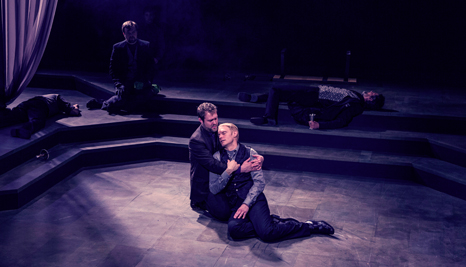
Learning from Live Theater
Students realize gains in knowledge, tolerance, and more
by Jay P. Greene
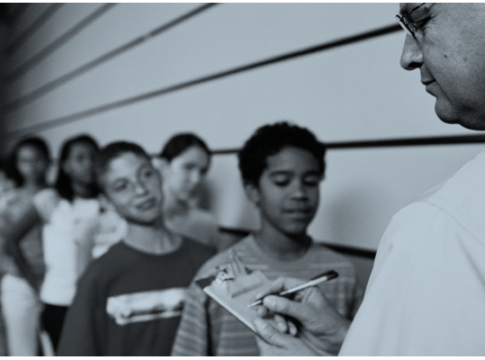
Getting Ahead by Staying Behind
An evaluation of Florida’s program to end social promotion
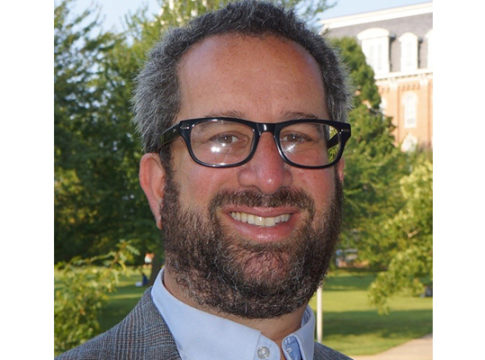
Straight Up Conversation: Scholar Jay Greene on the Importance of Field Trips
by Frederick Hess
The 10 Benefits of School Field Trips: Why it’s Crucial to Learn Outside the Classroom

Everyone (read: students) knows the best part about school is the field trips. Students get to get out of the classroom and into the real world, even if just for a few hours. These trips, no matter where they are, are formative for children . Whether it’s learning how to shuck corn on the grounds of a historical park, studying the tribal gear in an African art exhibit, or understanding how gravity works at the science museum , these hands-on learning experiences give children the ability to do things that can’t always fit inside the four walls of a classroom .
In this article, we’re going to share with you the 10 benefits of school field trips and why it’s crucial for children to learn outside the classroom.
The 10 Benefits of School Field Trips
Students do better in school.
Leaving school actually makes students do better when they get back to school. We’re not talking about suspensions or weekends or holidays or vacations. We’re talking about field trips .
Regardless of gender, ethnicity or socioeconomic status, students who go on field trips have better grades, higher graduation rates from high school and college, and greater income [1]. In fact, in a study conducted by the NEA, 89% of adults said educational trips had a positive, lasting impact on their education and career because the trips made them more engaged, intellectually curious and interested in and out of school.
Students learn more social skills
By getting out of the classroom and into a new place that encourages learning in a different aspect, students have the opportunity to do more than learn. They have the chance to talk to new people. These social skills they acquire help them learn things that they can’t in textbooks or in workbooks.
Students can visit new places
Not everyone has the financial means to visit museums and art galleries and historical landmarks. So these field trips give children the opportunities to see places they may not regularly visit.
Field trips exist not just to provide economically useful skills in numeracy and literacy, but also to introduce people to arts and culture. More-advantaged families may take their children to these cultural institutions outside of school hours, but less-advantaged students are less likely to have these experiences if these trips do not provide them.
With field trips, public schools viewed themselves as the great equalizer in terms of access to our cultural heritage [2].
Students can become critical thinkers
Field trips are more than going to a new place and getting out of school for the day. Everywhere you go can turn into a learning experience.
Students who go on field trips are known to have become more observant, noticing and describing more details in image or exhibit [3]. Being observant and paying attention to detail is an important and highly useful skill that students learn when they study and discuss what they see on field trips.
Students learn by experiencing, not just by studying “theory”
When students leave the classroom, they see the connections between what is happening at school and in the “real world.” They begin to see that what they learn within the walls of the classroom can help them solve the problems they see in the world around them, and can have a direct impact on who they become as adults [3].
Students learn more time management skills
A lot goes into a field trip, and while teachers, chaperones, and workers are the ones in charge, it’s also up to students to figure out what exhibits they want to learn about, how much time they need to eat, and when they can manage to visit the gift shop at the end of the trip.
Field trips give students perhaps their first feel of independence, even if dozens of adults are watching over them.
Students get to learn by doing
Think of the science museums and historical parks around your area. The classes they offer and the exhibits they show. The things students can learn that they wouldn’t otherwise get to inside a classroom. That’s because not all students can get the full education they need when they learn from textbooks and reading and application.
Each person has a different way of accumulating knowledge. While some prefer listening to learn better, others need to write or they only need to read the text or see a picture to later remember. The learning styles can be classified in visual, auditory and kinesthetic [3]. The distribution of the three learning styles is 65% visual, 30% auditory and 5% kinesthetic.
Field trips give these more unique learners a chance to, well, learn.
Students learn more teamwork skills
While on field trips, students typically get the chance to work together to solve simulated problems associated with the place of the field trip. Differing from group projects in school, these “real world” simulations allow children to put their teamwork skills and critical thinking skills to good use.
Students develop a stronger connection to the community
Communities are often rooted in a rich sense of history. By getting out of the classroom and into the streets, students can learn that there’s more out there than their little insular bubbles. School can bog students down, so it’s important to remind them how much is out there, even in our own community.
Students learn more leadership skills
Learning about people and places on field trips give students a chance to step out of their comfort zone. It gives children the chance to step up when they’re out in public. A leadership opportunity as simple as making a child the student leader in a group gives students the chance to test themselves and build relationships with those around them.
Buying Guide
Remember the trip you went on by bringing a Polaroid camera from Unique Photo .
This camera will need immediately printable film from Retrospekt .
If you have a cell phone and it’s allowed on the field trip, don’t let it die while you’re out. Purchase the ZAGG portable charger case. And don’t forget to charge the case before the trip.
No matter where you go on a field trip, chances are you’ll be taking a drive to get there. Stay hydrated with a vibey crystal water bottle from Vorda .
Pack all of your belongings in a Fjallraven backpack.

External references

- NEW! – Broadway
- Latest Guide
- Previous Editions
- NorthEast Field Trip Guide
- Southeast Field Trip Guide
- Band & Choir Trips
- Where to Go
- Site InSpections
- Field Trip Ideas
- Virtual Field Trips
- Planning Advice
- Los Angeles
- New York City
- Philadelphia
- Rome, Italy
- San Francisco
- San José, Costa Rica
- Washington D.C.
Select Page
How to Plan an Educational Field Trip for Students
Features , Planning Advice
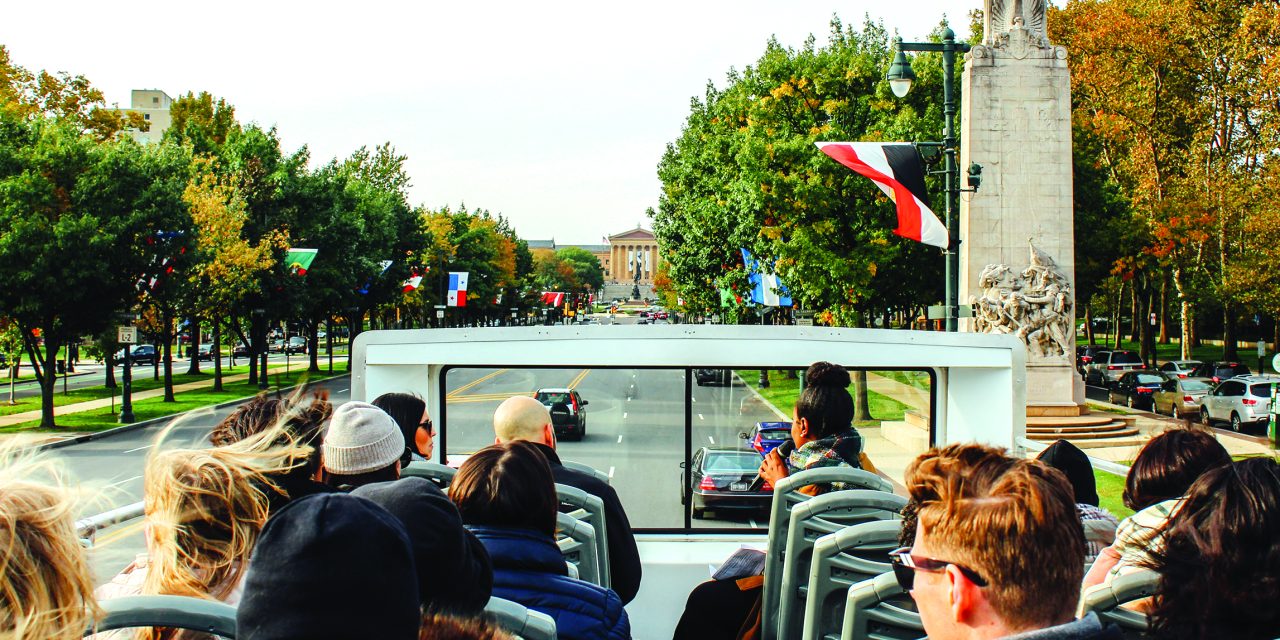
We help you craft a fun and engaging educational student itinerary packed with exciting learning in real-time settings outside the classroom
As an educator or trip organizer, educational field trip planning can be a rewarding experience if you have a clear roadmap and tips for creating an engaging itinerary. It’s crucial to design field trip itineraries that not only offer fun activities but also provide intellectual stimulation and opportunities for experiential learning. This approach fosters a deeper understanding and retention of knowledge among students.
Discover more amazing resources for student travel planners and educators when you Subscribe for FREE to Student Travel Planning Guide today.
By strategically planning your field trips, you can create a balance between educational value and exciting adventures. This approach ensures that students not only enjoy the trip but also gain maximum educational value, turning field trips into immersive and memorable learning experiences.
Here is a guide on how to craft student itineraries for field trips that are not only entertaining but truly enriching, intellectually stimulating and unforgettable.
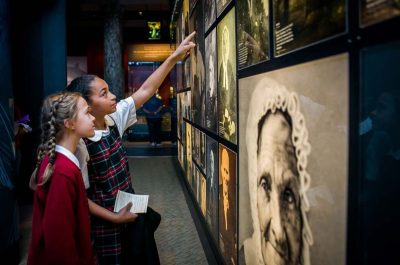
Connect Student Field Trip Activities to the Curriculum
One of the most impactful strategies to boost the educational value of a school field trip is to integrate the itinerary with your classroom curriculum. By planning your field trip in conjunction with your curriculum, you ensure that the trips content directly complements what students are studying, making their learning experience more comprehensive and meaningful.
Planning your curriculum and educational field trips together allows you to seek out destinations, landmarks, museums, parks, and experiences that directly relate to and expand upon what students are learning in the classroom. Not only are you saving yourself time by planning both together, but your curriculum can also provide a crystal-clear map for topical and sensical field trip planning.
For example, a history class studying the American Revolution will get far more educational value out of a trip to Boston steeped in significant historical sites versus a more generic itinerary that visits a history museum, which provides little experiential components.
Example itinerary for student groups:
Day 1: Start at the Boston Massacre site for an immersive historical reenactment. Then, visit the Old South Meeting House, the staging ground for protests like the Boston Tea Party. End the day at the Boston Tea Party Ships & Museum, where you can participate in interactive multimedia experiences.
Day 2: Walk the famous Freedom Trail, passing sites like the Paul Revere House, Old North Church and Bunker Hill Monument. Tour Harvard University’s historic colonial-era buildings. Have lunch in America’s oldest public park, Boston Common.
Day 3: Travel to Lexington & Concord’s Minute Man National Historical Park, witnessing the hallowed grounds where the first Revolutionary War battles occurred. Tour the Hancock-Clarke House where Hancock and Adams took refuge. Conclude at Emerson’s house and Old Manse, two historic Concord sites intertwined with the Revolutionary era.
By carefully curating a field trip itinerary that directly aligns with their curriculum, students can experience history in a tangible way. This reinforces their classroom learning and creates lasting memories that will solidify their understanding of this pivotal era in American history.
Integrate Reflective Learning for Students
Students absorb and retain more information through experiences, and reflection is a key component of experiential learning. Consider building time into the itinerary for students to reflect on what they’re seeing, doing, and learning while on the trip, while the information and experiences are still fresh.
This could take the form of journaling prompts, small group discussions, or a creative activity like drawing or photography accompanied by student impressions. Encouraging students to actively process their experiences in real-time with an activity will help them solidify what they’ve learned and integrate it into their classwork later.
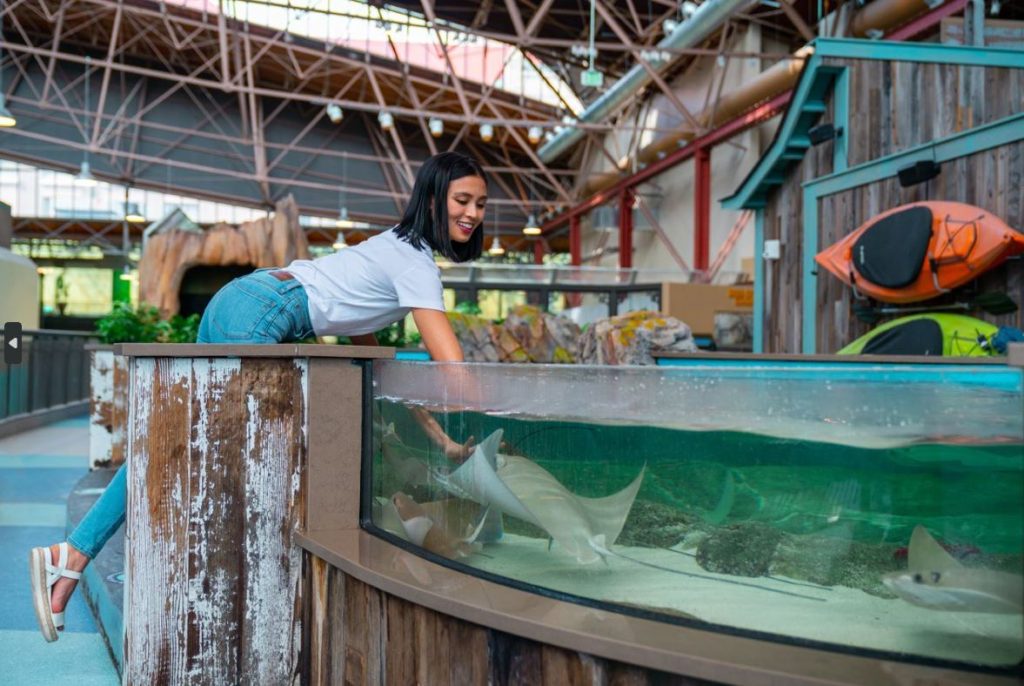
Include Cultural Immersion on an Educational Field Trip
Travel offers students incredible opportunities to experience different cultures firsthand. Whenever possible, consider including authentic cultural activities or interactions with the local community on your itinerary.
This could be a hosted meal at a local family restaurant, a neighborhood walking tour led by residents, or a school visit to meet and engage with local students. Cultural immersion fosters greater global understanding and social skills in all facets of a student’s life.
Perhaps there are cultural landmarks or museums showcasing artifacts related to the area and its people past and present. Many places of cultural significance have regional museums that provide guided tours and lectures for classes, providing an enriching experience for students while supplementing their classroom education.
Plan Hands-On Workshops for Students
Lectures and tours certainly have their place on class field trips, but students learn best by doing and engaging their left and right brains at the same time. Look for interactive workshops and classes relevant to the trip’s educational themes.
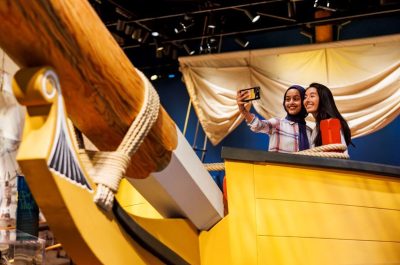
- For a marine biology-focused itinerary, check if the local aquarium offers a dissection lab for high school groups.
- Culinary arts students will gain much from a hands-on cooking class in regional cuisine for grades 8-12.
- At Plimoth Patuxet Museums in Massachusetts, students can partake in Wampanoag Workshops, learning traditional skills like hide tanning, pottery, and gardening directly from Native educators. They offer workshops for pre-k to college students .
- The National World War II Museum in New Orleans features many STEM workshops and student programs for multiple grades. They also provide Field Trip Plus for an immersive 45-minute, museum educator-led interaction for student groups grades 3-12.
- At the Museum of Science in Boston, students can participate in hands-on engineering workshops where they design, build, and test prototypes like wind turbines, ensuring an immersive STEM learning experience.
- George Washington’s Mount Vernon estate offers an interactive Colonial Classroom program, allowing students to step into the roles of students from the 18th century, practicing penmanship with quill pens and exploring early American curriculum.
The more hands-on the experience, the more impactful and memorable the learning is for your students. These are just some examples of the myriad workshops available for student groups on field trips.
Tap Local Experts for Student Groups
Enlisting local experts as speakers, guides or facilitators can elevate an itinerary’s educational quality. Reach out to university scholars, scientists, artisans, and community leaders at your destination who can share their niche expertise with students. A great place to start is your destination’s local visitors bureau.
Some examples might include:
- A geologist’s guided hike that will illuminate more than just the typical sights.
- An oceanographer could do a hands-on workshop at the lab or on the beach where children can interact with wildlife and ask questions.
- An archaeologist may organize a mock dig site and bring artifacts for students to examine while teaching excavation and preservation techniques.
- A meteorologist might conduct an interactive workshop on weather and atmospheric science.
Leave Room for Student-Led Discovery
While it’s good to have a thorough student itinerary, be sure to also give children some freedom to follow their own curiosity. Unscheduled time to explore a museum, gallery or neighborhood lets students delve into what interests them most.
Having a choice in their own learning path boosts engagement and takeaways. If a child or group of children show a keen interest in sharks while at the aquarium, have a parent or teacher stay with them for some extra time at the shark exhibit to ask questions and interact with the sharks along with the staff.
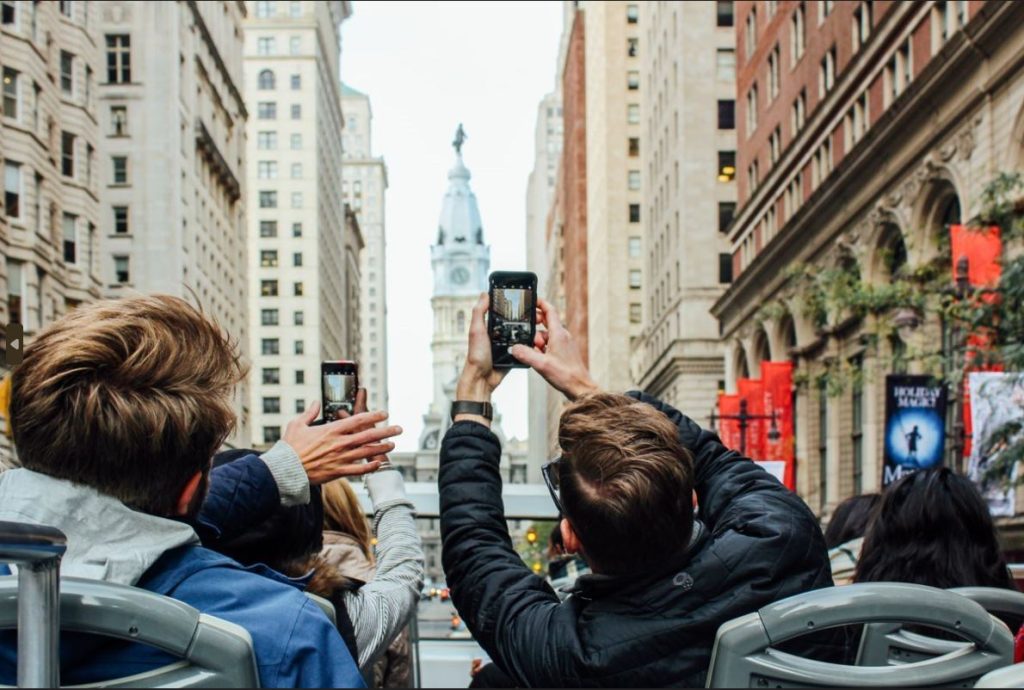
Choose Suppliers with an Educational Ethos
The vendors and suppliers you select can greatly influence a student itinerary’s educational value. Seek out accommodations, restaurants, tour providers and activity partners that share your learning objectives. Many vendors and suppliers offer educational programs or content designed specifically for student groups. Ask about customized classes or tours aligned with your curriculum.
With a learning-centric approach to student itinerary design, class trips become more than just a fun getaway—they’re a meaningful extension of the classroom. Educational travel helps students develop critical thinking, cultural sensitivity, a broadened worldview and curiosity that will serve them well at school and beyond for years to come.
Did you enjoy this content? For more tips on crafting impactful student itineraries, Subscribe for FREE to our Student Travel Planning Guide today.
By Ashley Dale, Contributing Writer and Homeschooler
Header photo: Big Bus Tour courtesy of PHLCVB/K. Huff

RECENT STUDENT TRAVEL PLANNING GUIDE ARTICLES

- Cash Rewards Credit Card
- Personal Loans
- Home Mortgage
- Student Loan
- Self-Guided Planning
- Planning with a Financial Professional
- 403(b) Plans
- Traditional & Roth IRAs
- Group Term Life Insurance
- Accidental Death and Dismemberment Insurance
- Guaranteed Issue Life Insurance
- Accident and Injury Insurance
- Disability Income Protection
- Dental and Vision Insurance
- Pet Health Insurance
- Medicare Supplement Insurance
- Auto & Home Insurance
- Renters Insurance
- Condominium Insurance
- Discount Marketplace
- Discount Tickets
- Auto Buying
- Wireless Program
- Complimentary Life Insurance
- Student Debt Navigator Tool
- Mental Health App
- Travel Rewards
- Job Layoff Assistance
- Disaster Relief Assistance
- Family & Wellness
- Life Insurance Protection
- Living in Retirement
- Paying for College
- Personal Finance
- Retirement Learning Center
- Shopping Discounts
- Student Loan Debt
- Travel & Vacations
Get Started
Create an account to get started, or if you already have an account, sign in below
How Field Trips Boost Students’ Lifelong Success
Educational trips contribute to better student outcomes in school and beyond. maximize the impact of field trips on students with these 9 ideas..
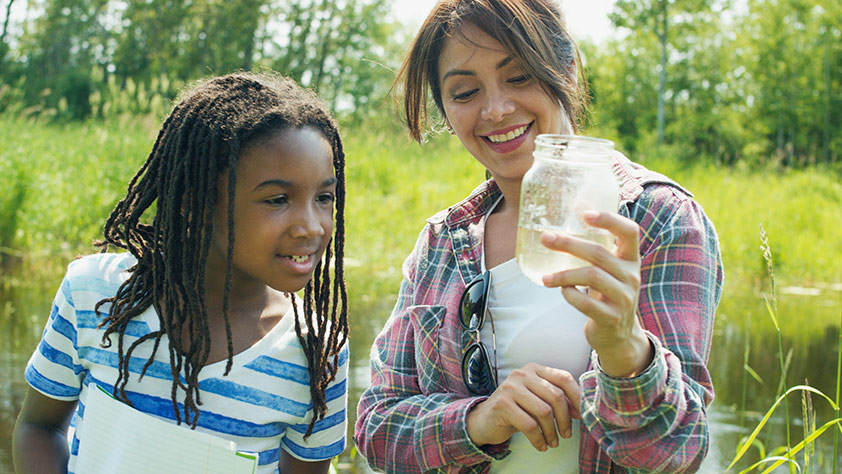
by NEA Member Benefits
Here’s why field trips are important
The study found that regardless of gender, ethnicity or socioeconomic status, children who take school trips have better grades (59%), higher graduation rates from high school (95%) and college (63%) and greater income (12% higher annually).
In fact, 89% said educational trips had a positive, lasting impact on their education and career because enriching field trips made them more engaged, intellectually curious, and interested in and out of school.
“When I was growing up, my parents said the 3 Rs (reading, writing and arithmetic) were important,” says Roger Dow, president and CEO of the U.S. Travel Association. “But for my kids, I made ‘roaming’ the fourth R. We live in a global society, and if you don’t see outside the neighborhood you grow up in, the world will pass you by. Traveling has opened my kids’ eyes. It’s made them more confident and inspired them to reach outside their normal environment to learn and obtain skills to bring them to the next level.”
More benefits of school trips
Margy Natalie, acting onsite learning manager at the Smithsonian Institution’s National Air and Space Museum , notes the powerful effect school trips can have on student learning: “Field trips give students the opportunity to learn in a natural environment and experience things first-hand and from primary resources, rather than texts; real objects rather than photos.”
Carylann Assante, executive director for Student & Youth Travel Association (SYTA) and SYTA Youth Foundation , seconds the notion that real world exploration outside the classroom can bolster students’ critical thinking skills. “Today’s students are visual learners, and a field trip lets them touch, feel and listen to what they’re learning about, which helps them build on classroom instruction, gain a better understanding of topics, build cultural understanding and tolerance, and expose them to worlds outside their own.”
Assante says field trips are particularly important for disadvantaged students, as they provide students with unique opportunities that level the playing field. “Field trips give diverse and financially-in-need students equal opportunity to experience things outside classroom that their families may not be able to afford,” she says.
A field trip can also be the first trip a student takes without their parents, so it builds independence, as well. “There’s a reason people say I need to get away and recharge my batteries. There’s truth to it,” Dow says. “If I was a school system looking at these stats, I couldn’t afford not to make this a part of our curriculum.”
Tips for planning a successful field trip
You’ve decided to plan an educational field trip for your class, whether it’s to an art museum, science museum, historic site, aquarium, planetarium or some other immersive, interactive learning environment. Now, you need to know what steps to take to ensure a successful field trip. Keep these expert tips in mind:
1. Look around your region for interesting day trips
Dow suggests a planned field trip so you and your class can easily explore an aspect of local history on a day trip. “You can take a quick drive and see the history of places around you—there’s tons of inexpensive things teachers can do that will have a phenomenal impact,” he says.
2. Do your homework
Ideally, you could scope out the destination in advance to ensure the field trip will produce your desired learning experience. “Plan carefully, do your research, visit the site before you plan, ask questions and take recommendations of staff,” Natalie suggests.
3. Follow protocol
“Teachers need to review their school’s policies on field trips in advance and prepare the forms with specific learning objectives and how the field trip will accomplish those objectives tied to their school's core curriculum,” Assante says. Most museums, attractions and locations have education materials to explain how their attraction supports teacher lesson plans and educational curriculums.
4. Involve your students in the preparation
Prepare your class for their upcoming school field trip by getting them interested and excited about what their experience may be like. “Discuss the goals of the field trip in advance, talk about what they will see and what they should learn,” Natalie says.
Consider letting the class pick the field trip destination so they have ownership and will feel invested in it, Assante suggests.
5. Make trips relevant to classroom instruction
“Base your field trips on your content area. If you’re studying ancient Egypt, don’t take them to Jamestown,” Natalie says. “Focus on how the trip fits into your content or another educational goal. A field trip should be a day out, not a day off.”
6. Incorporate technology
“Many students use their mobile devices to engage with the field trip in the classroom with apps and blogs,” says Assante. This can help create an interactive learning experience that engages students during the trip, and then reconnect with that experience later in the classroom and at home.
7. Engage the senses
Select a field trip destination where students won’t be sitting down, like they typically do in the classroom. They should be able to touch, explore and share their experiences, Assante says.
8. Fundraise to cover any extra costs
“Engage the parents, PTA or other teachers to support school-wide field trips and help raise the funds so everyone can afford to attend the trip,” says Assante, who also notes some large companies even offer field trip grants.
If you’re looking for deals on tickets to attractions and events, see if you can cut the costs of the admissions fees with the NEA Discount Ticket Program .
9. Follow up on the lessons learned
“Students are much more likely to write about an experience they recently had, like the field trip, than a random prompt,” says Natalie, who recommends following up with graded assignments. “Have each student write about their favorite artifact or activity on the field trip, or why this field trip is important to keep, or conversely, how a different field trip might be better.”
Search for travel deals for NEA members
Nea discount tickets program.
Enjoy unique access and deep discounts to must-see places, events and shows. Get up to 40% off tickets to Disney World, Universal Studios, Cirque du Soleil, AMC Movies, Broadway shows, concerts, sporting events and much more!
NEA Travel: Car Rental
Save up to 25% when you rent a car through the NEA Travel Car Rental program. Compare rates at companies such as Avis, Budget, Enterprise and Hertz and pick the best deal for your budget.
NEA Travel: Hotels
Save up to 60% when you book through NEA Travel. And with guaranteed price matching you can rest assured that you’re getting the best hotel price.
NEA Travel: Flights
Find low fares and book a flight to your favorite locales or far-off destinations. Compare rates from multiple carriers to find the best trip for you.
NEA Travel: Cruises
You’ll find the best cruise deals, exclusive offers and amenities from the top cruise lines such as Disney, Carnival and Royal Caribbean.
You might also like

Your Pass to Fun: Get Discounts on Tickets to Popular Attractions
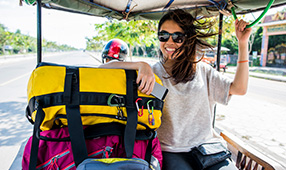
8 Little-Known Vacation Deals for Teachers
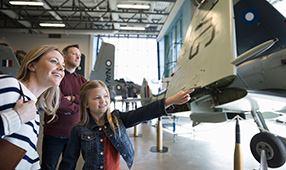
How to Enjoy Great Museums for Free
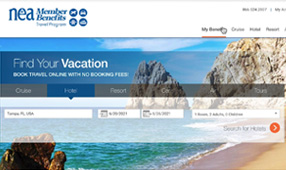
Finding Travel Deals Is Easy With the NEA Travel Program
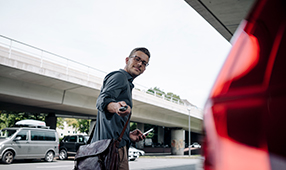
Car Rental Made Quick and Easy

How to Plan a Vacation Without Going Into Debt

Easy Ways to Save Money on a Road Trip
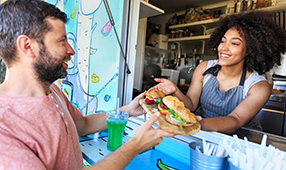
How to Dine on a Dime While Traveling

Travel the World With Grants Just for Educators

Don’t Miss These Top Discounts for Teachers and Education Professionals

Get Easy Access to Our Most Requested Deals and Discounts

A New Way for NEA Members to Find Exclusive Shopping Discounts
- Skip to global NPS navigation
- Skip to the main content
- Skip to the footer section

Exiting nps.gov
Ten tips for a successful field trip.
Planning a field trip to a national park near you? Here a 10 quick tips to help you and your students get the most out of your trip:
- Plan everything well in advance. Call to schedule the field trip or request an educational fee waiver, get a confirmation, and make necessary arrangements for school and parental permission and transportation. Plan the educational experiences and activities for the field trip. Know how to get to the field trip site, how long it will take, and where you will have lunch. Bring along any supplies and materials needed for activities that you have planned. Share this with all the teachers and chaperones involved.
- Use pre-visit activities to help prepare the students for the field trip. Make field trip planning a part of in-class learning.
- Develop clear learning objectives and share them! Make sure that the students and other teachers know these objectives.
- Chaperoning is not a spectator sport. Chaperones can be a big help if they understand their role.
- Give everyone nametags. Make sure that even the teachers and chaperones are wearing readable nametags. It also helps to divide large groups into smaller sub-groups before the trip and color code their name tags.
- Keep the students engaged. Encourage the students to participate in the activities but remember you are responsible for their behavior.
- Keep students accountable for learning. A field trip is not a day off from school! Did you accomplish the planned learning objectives?
- Encourage independent observation time. Constructive free time can help make the trip more memorable.
- Bring the experience back home. Use post-visit activities back in the classroom to make the field trip relevant and reinforce concepts.
- Use evaluations and sharing. Improvements can only be made through honest feedback and evaluation.
You Might Also Like
- shenandoah national park
- field trip preparation
- field trips
Shenandoah National Park
Last updated: August 30, 2023
- Forms for Educators
- Apply for a discount
- Sign Up for Free

- Educational Technology
How to plan a school field trip
Steps to planning a school field trip
- Commit to early planning
- Decide on your destination
- Get buy-in from administrators
- Contact the site
- Arrange transportation
- Plan food options
- Recruit chaperones
- Prepare students for the trip
- Get permissions from parents
Students love field trips — especially since they break up the normal school routine — but they’re often stressful for the educators who have to plan them. Pulling off a successful school field trip requires an enormous amount of preparation and organization, but it all translates into a rewarding educational experience for participants that has a long-lasting, positive impact.
According to a study cited by the National Education Association , students who took part in school field trips had better grades and graduation rates from both high school and college. They also eventually earned a higher income than their counterparts who hadn’t participated in such trips as students.
The hands-on, experiential learning students get from school field trips delivers a lot of other benefits — like increased knowledge retention, a more developed sense of independence, access to other cultures that broaden students’ horizons, and the chance to bond with other students and create life-long memories.
And the planning part? It doesn’t have to be daunting if you start early. Plus, we’re making it a little easier by giving you nine tips for organizing a successful school field trip and 23 field trip ideas.
9 steps to planning a successful school field trip
1. commit to early planning.
The earlier you begin planning, the less stressed you’ll be if and when obstacles arise. There are a lot of details to iron out, such as
- Researching and selecting a destination
- Getting feedback from administrators, parents, and students on the destination
- Planning the educational portion of the trip
- Getting parental permissions
- Arranging transportation
- Figuring out a meal plan
- Recruiting chaperones
Giving yourself a long lead time will help you tackle any unexpected snafus along the way.
2. Decide on your destination
Do some initial research and brainstorm potential school field trip destinations based on your learning objectives and curriculum goals. Consider location, cost of entry and parking, the ages and number of participants, the duration (e.g., a day-long excursion or an overnight trip), and any other key details that factor into the selection of an appropriate field trip destination.
Once you come up with a couple of good options, get feedback from colleagues, administrators, parents, and, if appropriate, the students themselves.
3. Get buy-in from administrators
Once you’ve decided on the ideal location for your field trip, be sure to get clearance from the appropriate administrators before you discuss trip details with students. You don’t want to get their hopes up if the administration rejects your carefully laid out plans!
Share the costs, the benefits of the trip for students, the days and times for the trip, and any other relevant details to help get the administration on board.
4. Contact the site
Once you have a “yes” from the powers that be, get in touch with the site and confirm that your preferred days and times are available. Make reservations if necessary, find out about group rate discounts and cancellation policies, pay any required deposits, and verify the site is accessible to those with disabilities. You can also share the number of children that will be in attendance and the special needs your students have, if any.
If it’s possible, conduct a site visit before the trip to get the lay of the land, locate the restrooms, note where students will be eating lunch, and any other relevant information it would be helpful to know before the field trip.
5. Arrange transportation
Now that you know where you’re going and when, it’s time to plan how you’re going to get there. You’ll likely travel by school bus, but if your group is smaller, you might get there in staff vehicles or even via public transportation. If you’re using school buses, you’ll need to reserve them in advance to be sure they’re available the day of your excursion, and you’ll have to fill out the required forms.
6. Plan food options
Of course, a day-long outing is going to require some serious planning, because no one wants a bunch of hungry kids on their hands!
There are a few options for food. Students can bring their own lunches, which can make things easier for everyone. Or you can make plans to eat at an onsite restaurant or cafeteria if one is available (which you may be able to reserve in advance).
Then there’s the option of eating at a restaurant, which might be the least palatable choice, given that kids might get unruly, you or they will have to handle money, and ordering could take a long time.
7. Recruit chaperones
Depending on the age of your students and the activities you’ve planned, it’s best to have a ratio of at least one adult to every 10 kids. If the students are younger, you may want more adults present.
You’ll need to recruit and confirm chaperones at least two to three weeks in advance, and be sure you have a list of alternates in case a chaperone has to drop out for any reason. Be clear with your chaperones that this is an educational trip and clearly share what you need them to do.
8. Prepare students (and parents) for the trip
Once all of your plans are in place and everyone’s excited, it will be time to share trip details with students and parents, and let them know what’s expected of them.
Hold an informational meeting for parents to discuss trip details, chaperone information, and rules and expectations regarding students.
Share trip rules with students and be clear about appropriate behavior. Let them know what the day’s itinerary looks like, what to bring, what to wear, and what not to bring (for example, anything of value that could get lost or stolen).
9. Get permissions from parents or guardians and automate the process where possible
Gathering permission slips from parents for school field trips is essential. Jotform can help simplify the process. If you want some tips to make this easier, check out our guide on how to collect online permission slips from parents .
We’ve also made it easy to automate your field trip planning with all the forms, tables, and templates you need for a successful school field trip:
- Field trip interest form
- Field trip permission form
- Field trip approval request form
- Field trip signup sheet
- Field trip permission slip template
And last, it probably goes without saying that you should be prepared in case you run into any emergencies. Bring along an emergency or first aid kit, and keep a list of parent contact information on hand.
Now that you have your planning to-dos sorted, how about some field trip ideas?
23 field trip destination ideas
Here are a few destinations that would make ideal learning experiences for students, depending on your curriculum goals and objectives:
- Botanical gardens
- Nature centers, bird sanctuaries, and wildlife refuges
- State and national parks and other natural attractions
- County and city parks
- Farms, orchards, greenhouses, and nurseries
- Community gardens
- Historic sites
- Planetariums
- Art galleries
- Cultural centers
- Radio and television stations
- Newspaper or local publication offices
- Police and/or fire stations
- Animal shelters
- Behind-the-scenes theater tours
- State Capitol Building and/or county buildings
- Local businesses
- Colleges and universities
If an onsite field trip isn’t feasible, you can plan a virtual school field trip as an alternative. Many of the organizations above can provide this service via video, guest speakers, demonstrations, or other presentations. Our handy virtual field trip registration form can get you started.
Try Jotform
Because Jotform loves educators, we have special pricing plans just for you. Get started today and receive a 50 percent educational discount for any paid plan . We have three plans to suit your needs:
- Bronze costs just $34 per month and includes 25 forms and 1,000 monthly submissions.
- Silver is $39 per month with 50 forms and 2,500 monthly submissions.
- Gold costs $99 per month and includes 100 forms and 10,000 monthly submissions.
We also offer a 30 percent discount on Jotform Enterprise for educational institutions. This powerful multiuser plan allows you to create beautiful, customized forms and protect response data securely online.
Hopefully, these nine steps, plus Jotform’s many resources for educators, will help you plan a stress-free school field trip that has a long-lasting, positive impact on everyone involved.
Photo by Norma Mortenson
Thank you for helping improve the Jotform Blog. 🎉

RECOMMENDED ARTICLES

What is Educational Technology?

How to collect online permission slips from parents

11 best class registration software solutions for 2024

The 7 best student management systems

5 tips for creating a virtual learning environment

What is a virtual classroom?

Online learning vs traditional learning

How teachers do it: Saving time with tech tools

10 educators you should follow on Twitter

LearnWorlds pricing plans: Which one is right for you?

Online Forms: A Teacher’s Best Friend

7 higher education apps to be more efficient in 2020

4 educational technology tools transforming the classroom

Using tech to keep students with food allergies safe

Can we talk? Better communication reduces teacher turnover

How to make a Bitmoji classroom

10 Schoology alternatives in 2024

10 best K–12 student information systems
The pros and cons of academic tracking

20 questions to ask alumni

How a Teacher Uses Jotform to Help Her Students

How to evaluate a teacher’s performance

6 Kajabi alternatives for offering online courses in 2024

8 tips for using Zoom for online learning
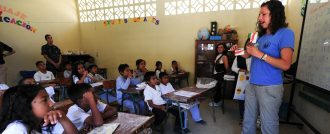
How technology can facilitate teacher peer reviews

The best software for teachers

How to hold virtual parent-teacher meetings on Zoom

Homework in digital classrooms

Back-to-School Tips for Teachers: Collecting Student Data

10 tips for healthy parent-teacher communication

How to host a virtual open house for your school

What is a learning management system?

Safe and private: How to use forms to facilitate social justice conversations with students

What’s the best classroom response system?

6 Jotform Features to Use for Back-to-School

35 top course evaluation question examples

What is distance learning?

Quizizz vs Kahoot!: Choosing the right quiz platform

The 12 best parent engagement strategies in school

How teachers can use tech tools to manage IEP compliance

Top 7 Quizlet alternatives in 2024
The importance of student attendance tracking software

The best 31 websites for teachers

How to create an online lecture

How to share your student data with colleagues

Top online gradebooks for teachers and schools

The anatomy of a data-rich teacher evaluation form

The 5 best online teaching platforms in 2024

LearnWorlds vs Thinkific: Which is best for online courses?

Comparing K–12 online education platforms: Schoology vs Google Classroom

How teachers can sort through EdTech tools

11 kindergarten teacher blogs that will inspire you (and make you laugh)

Automated schools: 7 school processes you can automate

Methods to utilize technology for school administrators

5 Jotform Widgets to Utilize This School Year

Moodle LMS pricing: Which plan fits your learning journey?

How to engage your alumni to support your school

15 podcasts for teachers to further professional development

3 of the top online learning platforms

How student data helps teachers and administrators plan for continuous improvement

Educational Uses of Jotform

Why is data important in education?

Top free software for students

Quizizz vs Quizlet: A close-up look at 2 top quiz tools

Top 8 fundraising platforms for schools

Data privacy 101: How to safely use cloud tools this school year

School web design: 3 tips to engage students and parents

12 best online lesson planners for teachers

Top 8 online quiz makers for teachers

7 presentation tools for teachers

How to offer virtual office hours to your students

9 of the best apps for parent-teacher communication

The best 26 teacher apps in 2024

Sending Your Graduation Party Invitations with Jotform

Google Classroom vs Canvas: Features, pricing, and more

Need new skills? These online learning platforms can help

Top 15 learning management system examples

4 sanity-saving ways for teachers to update parents

How to conduct a parent-teacher conference

How to embed a form on a Thinkific page

11 ways to use Jotform for distance learning

How to improve feedback in the classroom

4 tips to help you adjust to unexpected lesson plan deviations

Blooket vs Kahoot!: Comparing interactive learning platforms

Gamifying your curriculum with Blooket vs Gimkit

How EdTech supports inclusive classrooms

How to conduct remote student assessments

EdTech in 2025: A glimpse into education’s future

How private schools can recruit top students

How to minimize the disruption of school campus tours

Top 5 Kahoot! alternatives in 2024

How to design accessible online courses

Webinar: 6 ways Jotform Enterprise can help your school do it all

7 tips to improve the e-learning experience

How schools should approach long-term data management

Create digital reading logs for students with Jotform

Top 5 online assessment tools for teachers

How to manage a successful school fundraiser

Student survey questions: A guide for teachers

How to Use Jotform for Education (Movie)
Send Comment :

Quality Point(s)
- English (US)
What is the difference between a field trip and a school trip ?Feel free to just provide example sentences.
- Report copyright infringement

A school trip, as it suggests, is a trip organized by a school (usually high school or younger), while a field trip is any kind of organized trip for educational purpose, can be in college or at work
Was this answer helpful?
- Why did you respond with "Hmm..."?
- Your feedback will not be shown to other users.

@Bavly_S is correct, but I just wanted to add that ‘field trip’ can be used as a synonym for ‘school trip.’ Children in schools can go on field trips or on school trips and the meaning is exactly the same. The only difference is that ‘field trip’ can also be used for work/college organized trips, whereas ‘school trip’ can only be used for trips organized by a school.

The only difference I can think of that during a field trip you might have to undertake some tasks, whereas a school trip might just involve visiting a museum or something like that (i.e., you are not expected to do much other than be there).

Ask native speakers questions for free
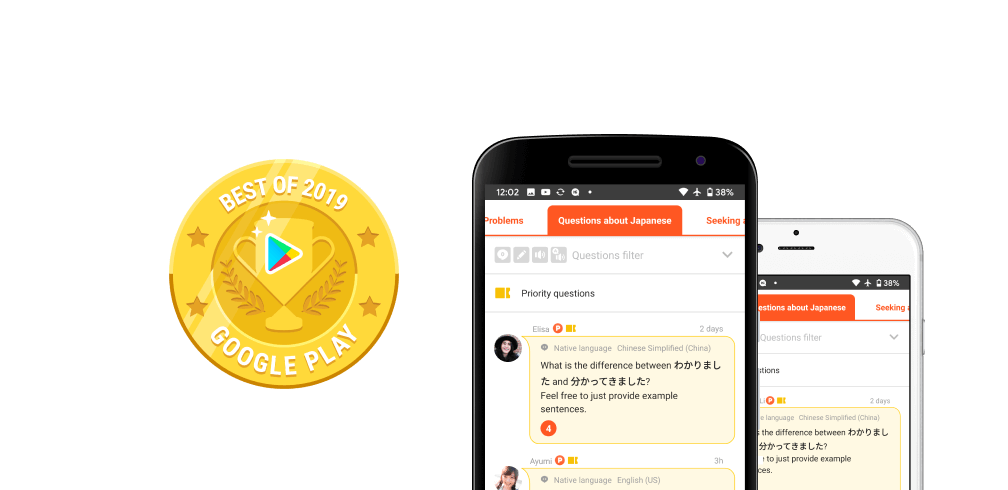
Solve your problems more easily with the app!
- Find the answer you're looking for from 45 million answers logged!
- Enjoy the auto-translate feature when searching for answers!
- It’s FREE!!
- What is the difference ...
- Grades 6-12
- School Leaders
Check Out Our 32 Fave Amazon Picks! 📦
260+ Field Trip Ideas for Grades Pre-K Through 12 (In-Person and Virtual)
Get out of the classroom and explore the world!
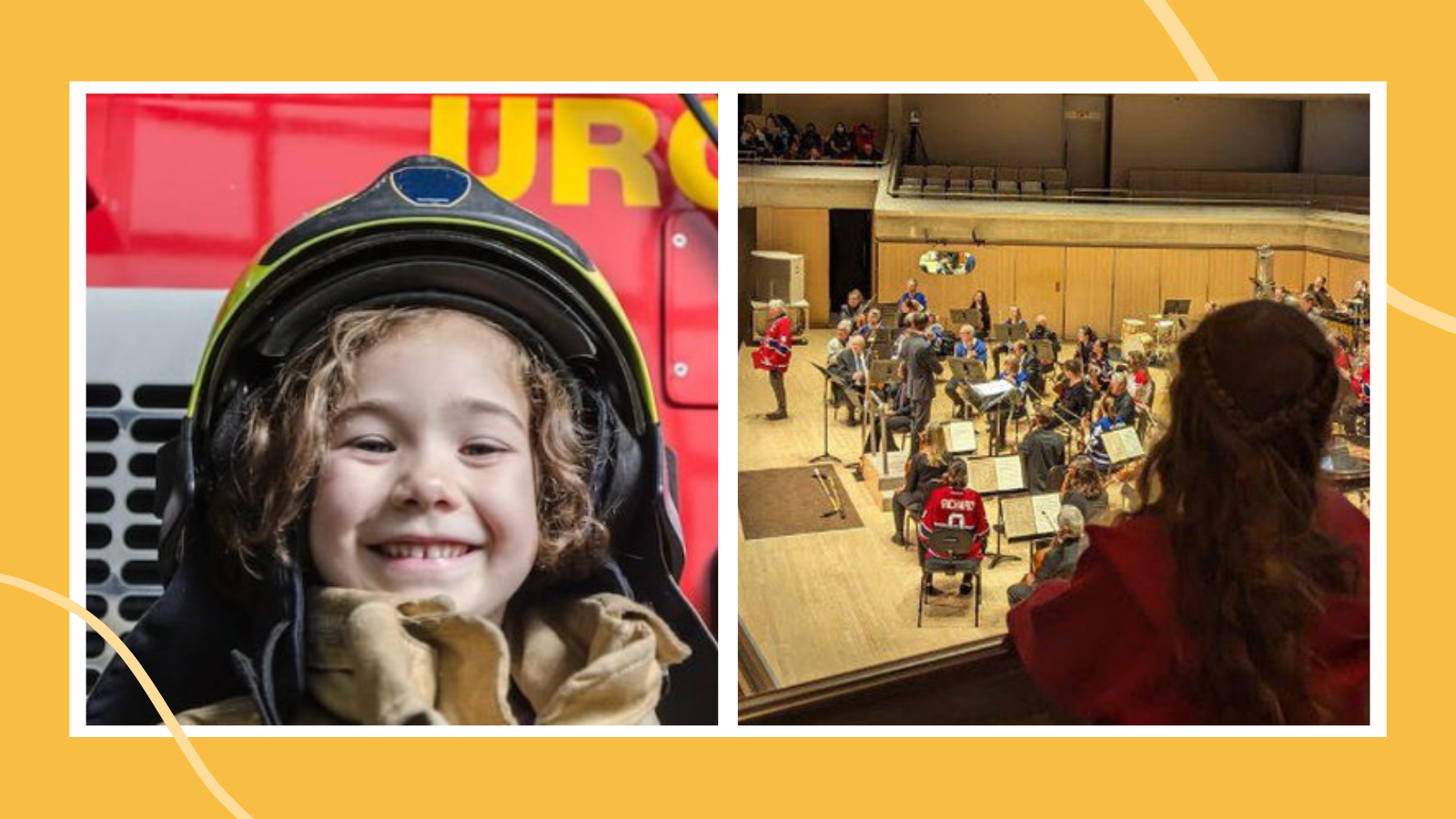
Field trips are a quintessential school experience. You usually only get one or two a year so it’s important to do it right! Our roundups of unique field trip ideas have something for every age, subject, and interest. We’ve even got resources like permission slip forms and chaperone tips. Get ready to leave the classroom behind to take learning on the road!
Preschool Field Trip Ideas
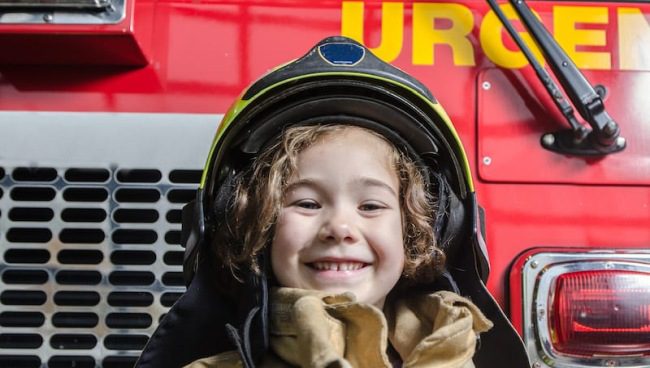
Early-grade field trips help kids learn about the world and also teach them good field trip behavior. These are our top picks for the pre-K crowd, but many of the options on our kindergarten list are perfect for this age group too.
- Library: Not every student’s parents take them to story time. Schedule your own trip, and show kids that having fun isn’t hard when you have a library card!
- Farm: Whether you learn how vegetables are grown or where milk and eggs come from, the farm is always a hit.
- Grocery store: Go behind the scenes at the supermarket, and use this trip as the foundation for lessons on healthy eating.
- Park: From local playgrounds to majestic national parks, it’s always worth getting kids into the great outdoors.
- Children’s museum: This is the age group most children’s museums were designed for! They’ll love all the hands-on fun and excitement.
- Post office: Learn how mail is sorted and shipped, and teach students about stamps and other mail-related items.
- Bank: Money is a new concept for these kiddos, and they’ll be fascinated to step inside the vault and learn other bank secrets.
- Fire station: There’s just something about a fire truck that gets every little one excited.
- Nursing home: Is there anything sweeter than watching seniors and wee ones spend time together?
- Animal shelter: For kids who don’t have pets at home, this can be a good introduction to animals. Others will just enjoy the time with dogs and cats waiting for their forever homes.
Elementary School Field Trip Ideas
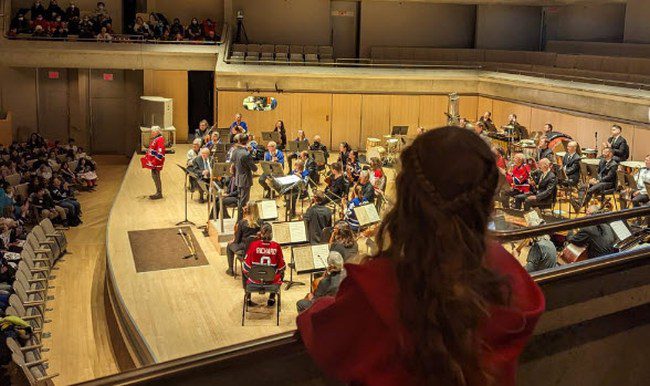
@mjdstoronto
These are the prime field trip years! Here are our favorite trips for every grade.
- 14 Kindergarten Field Trips (Virtual and In-Person)
- 15 First Grade Field Trips (Virtual and In-Person)
- 15 Second Grade Field Trips (Virtual and In-Person)
- 15 Third Grade Field Trips (Virtual and In-Person)
- 23 Fourth Grade Field Trips (Virtual and In-Person)
- 22 Fifth Grade Field Trips (Virtual and In-Person)
Middle and High School Field Trip Ideas
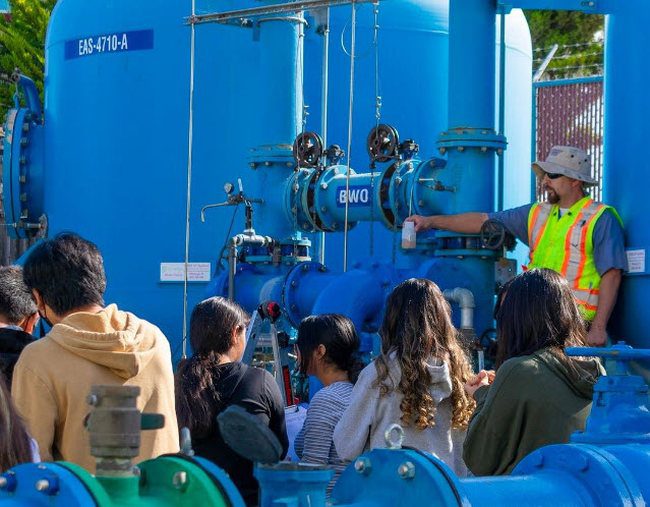
@salinasvalleybasingsa
For this age group, you’ll need to step up your game a bit. (They’ve probably already been to the zoo, the aquarium, and the art museum.) Try some of these locations, which offer educational, social-emotional, and real-life learning opportunities.
- Food bank: Hold a food drive, then arrange a trip to your local soup kitchen or food pantry. Volunteering makes for truly meaningful field trips.
- Recycling facility: In a time when reducing landfill waste is more important than ever, a trip to a recycling facility can help drive home the message.
- Theater: Many theaters offer behind-the-scenes tours for schools and discount pricing when you buy tickets in bulk. (Want to go virtual? Check out the Hamilton Education Program !)
- Community college: Parents sometimes take kids on college visits, but a community college trip offers opportunities for even more students to see themselves getting a higher education.
- TV station: Kids interested in communications or technology will find this completely fascinating.
- Courtroom: There’s no better way to understand the justice system than to see it in action.
- State or county capitol: Every government class should visit a local capitol to meet with officials and see how the government works.
- Local business: This can be a cool way to learn about managing a business, working with customers, or discovering how products are made.
- Wildlife rehab facility: Introduce students to the people who help injured wild animals recover and live free once again.
Virtual Field Trip Ideas
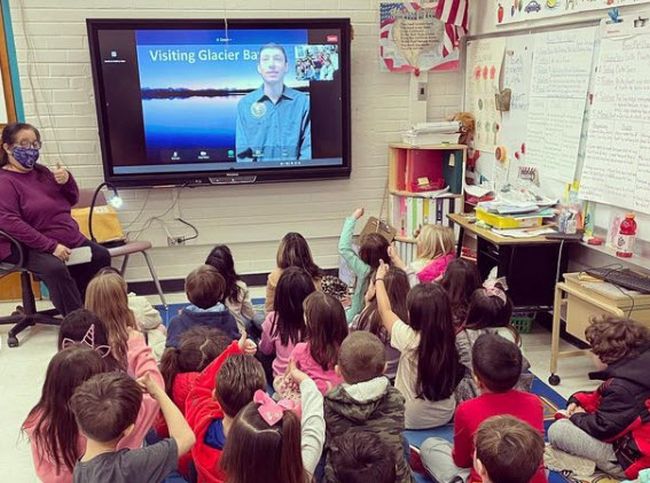
@edtech_tusd
The terrific thing about virtual field trips is that they eliminate so much of the hassle. No need to collect permission slips, arrange for buses, or recruit chaperones. Plus, they’re usually free!
- 40 Amazing Educational Virtual Field Trips
- 20 Terrific Virtual Art Museum Field Trips
- 18 Incredible Virtual Zoo Field Trips
- 15 Fascinating Aquarium Virtual Field Trips
- 3 Science Virtual Field Trips Let Kids Travel the World
Field Trips by Location
If you live in one of these cities, check out some of our favorite spots.
- 16 Cool Field Trips in Houston, Texas
- 21 Terrific Field Trips in Chicago, Illinois
- Top 10 Washington D.C. Field Trip Ideas
Field Trip Tips and Resources

There’s a lot to do when you’re organizing an off-site field trip. These resources are here to help.
- Preparing Parent Chaperones for a Field Trip
- Free Printable Field Trip and School Permission Forms To Make Your Life Easier
- Things To Do Before Taking Your Students on a Major Field Trip
- Mistakes To Avoid When Planning a Field Trip for Students
- Why I Hate Field Trips (And How I Learned To Deal)
- Help! Is There Any Way I Can Get Out of Our End of the Year Field Trip?
Bonus: Looking for a laugh? Check out Ways School Field Trips Are Like The Wizard of Oz !
What are your favorite field trip ideas? Come share your thoughts in the We Are Teachers HELPLINE group on Facebook !
Plus, virtual college campus tours to explore from home ..
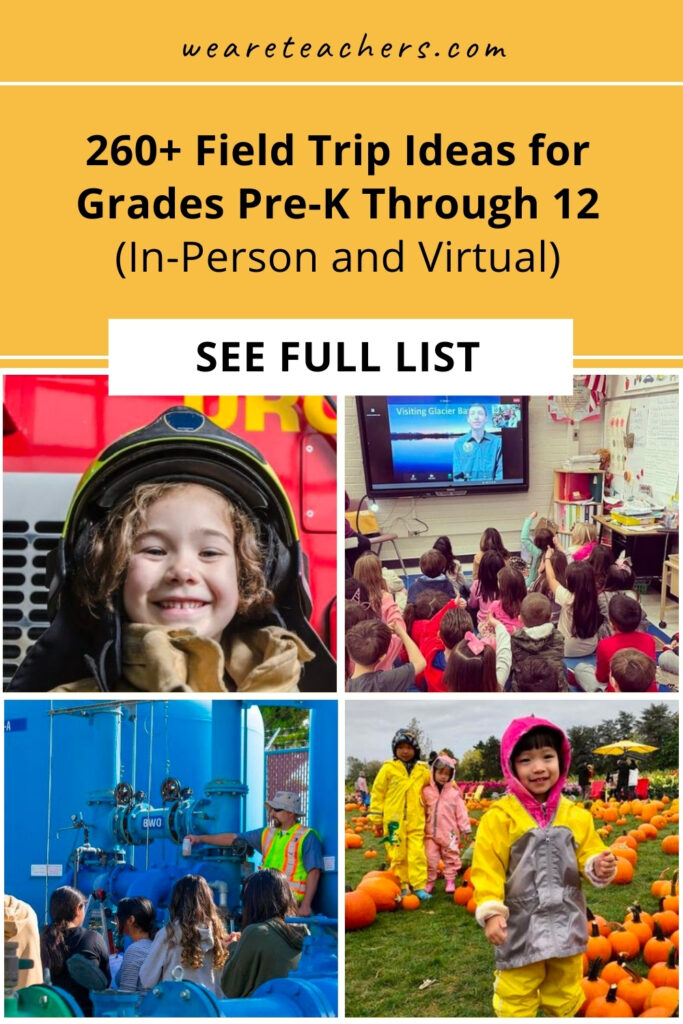
You Might Also Like
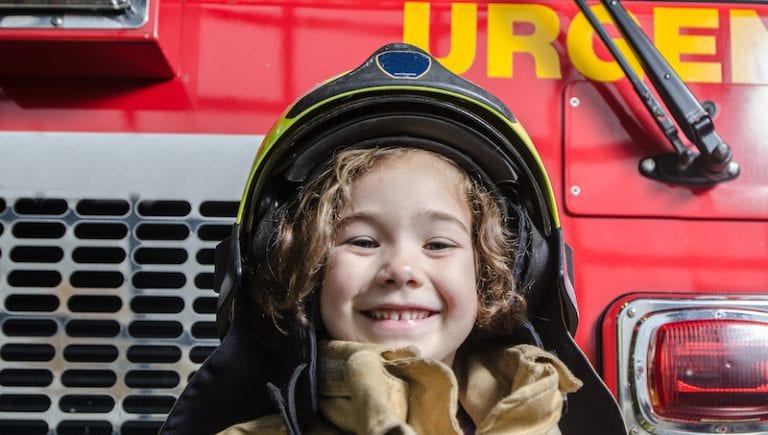
The Best PreK and Kindergarten Field Trips (Both Virtual and In-Person!)
From the pumpkin patch to the fire station. Continue Reading
Copyright © 2024. All rights reserved. 5335 Gate Parkway, Jacksonville, FL 32256
Want students to do better in class? Send them on culturally enriching field trips

School field trips have been part of the educational experience for children across the nation for decades. While many school administrators believe there’s intrinsic value in letting students develop socially with out-of-classroom experiences, quantifying the impact and the value of field trips is difficult. And justifying out-of-class time can be burdensome for teachers tasked with providing a good education amid the pandemic.
As such, many art venues, science museums and zoos have reported declines in field trip attendance. Teachers and students have also reported decreasing amounts of school-sponsored trips, particularly for minority students in academically low-performing schools.
But thanks to new research from BYU, Johns Hopkins University and the Heritage Foundation, the value of field trips is finally being understood and measured. The study, published in The Journal of Human Resources , found that students who participate in multiple field trips during the school year have higher test scores, perform better in class and have increased cultural conscientiousness over time.
“Contrary to practice where schools, facing accountability pressures, trade extracurriculars for increased seat time, we found that there’s no harm to academics by taking time out of the classroom,” said Heidi Holmes Erickson, assistant professor of educational leadership at BYU and lead author of the study. “It’s possible to expose students to a broader world and have culturally enriching curriculum without sacrificing academic outcomes, and it may actually improve academic outcomes.”
The study used an experimental design and randomly assigned fourth- and fifth-grade students from fifteen elementary schools in the Atlanta, Georgia, area to participate in three culturally enriching field trips during a school year. The field trips included a trip to an art museum, a live theater performance and a symphony concert.

Students who attended three different field trips in fourth or fifth grade scored higher on end-of-grade exams, received higher course grades, were absent less often and had fewer behavioral infractions. These benefits were strongest when students entered middle school.
“We anticipated that field trips wouldn’t harm test scores. However, we started seeing academic improvements and realized that students who participated in these field trips were doing better in class,” said Erickson. “One potential reason for this is that field trips expand students’ world concepts and expose them to new ideas. Similarly, students might be more engaged in school thanks to field trips. Students find school more exciting and want to try harder in class.”
In addition to the academic improvements, students who participated in multiple field trips were 12% of a standard deviation more likely to express a desire to consume arts in the future and nearly 14% of a standard deviation more likely to agree with the statement, “I believe people can have different opinions about the same thing.”
Researchers say this is more evidence that field trips are beneficial not only for academic success but for individual character development as well.
“Parents are very interested in the academic quality of their child’s school, but they’re also interested in the social skills and social engagement habits they develop. Cultural field trips are easy ways to help facilitate both.”
"It’s possible to expose students to a broader world and have culturally enriching curriculum without sacrificing academic outcomes, and it may actually improve academic outcomes."
Erickson says she’s hopeful this study will be a resource for policymakers and school principals who are interested in improving children’s growth during the children’s school experience. When considered in the context of the pandemic, she says this research should be a caution to administrators who are considering eliminating out-of-class opportunities.
“Field trips have been non-existent for the last two years, and many cultural institutions like museums and science centers were closed. Schools want to make up learning loss from the pandemic and might feel pressure to sacrifice a well-rounded education for increased seat-time,” says Erickson. “Field trips might be the first thing to go. Addressing student learning loss is crucial, but schools should be thoughtful in their approach.”
New York Daily News
Daily herald, related articles.

Championing heritage: BYU student Naloni Felix helps bring Native American stories to schools
BYU educators, Native American tribal leaders team up to enrich Utah elementary arts programs

Kendra Hall-Kenyon named dean of David O. McKay School of Education
- FACTS Family Portal
- Payment Plans/Financial Aid
- Tuition Management/Grant & Aid
- Student Information System (SIS)
- Family Login
- School Login

June 26, 2024
- Take Summer Learning Out of the Classroom with Virtual Field Trips
Summer is here, and for many students, this can mean a big potential for learning loss. This is the perfect opportunity for teachers to introduce new ways to keep students engaged and learning all year long, and what better way than taking students on virtual field trips? Explore new sights and experiences from anywhere and make learning something your students never miss out on.
What is a Virtual Field Trip?
Field trips are something every teacher is familiar with. It can be both fun and educational to bring together your whole class and explore museums, exhibits, or unique locations around your area. However, for some students and staff, it can be inconvenient or impossible to get together in person.
With virtual field trips, teachers can bring their class together anytime and almost anywhere to gain experience and explore without the constraints of a physical meeting location. Field trips have long been a way to get students out of the classroom while still gaining valuable learning opportunities and this online option can be the solution to prevent learning loss or students forgetting material they may have learned over the school year.
Virtual Field Trip Destinations
Going virtual doesn’t mean you have to limit yourself when it comes to the experiences you can enjoy with your students. From museums to attractions around the world, there are almost no limits to the things your students can experience with virtual field trips.
Many popular museums such as the Smithsonian National Museum of Natural History offer virtual tours, allowing your group to navigate various rooms and exhibits on your own time. Get a close-up view of unique artifacts and learn more about them with in-depth descriptions minus the crowds and distractions you may expect on an in-person field trip.
Museums aren’t the only virtual experiences you can bring your students to either. Explore other unique virtual destinations, like a digital trip to national parks or video tours in cities around the world.
Keeping Kids Active in the Digital World
Over the summer, you probably expect your students to spend more time playing and less time learning, but with virtual field trips, you can perfectly meet them in the middle. Adding these experiences to your summer learning plan can both combat learning loss and reinforce the things your students are learning in every lesson. Bring your students on a virtual trip to the Louvre and combine it with a thoughtful lesson in classical art. The options for keeping students engaged and entertained all summer long are almost limitless.
Summer learning and fun can go hand-in-hand. FACTS values making it easy for you to challenge your students all summer while still staying prepared, organized, and supported, letting you enjoy the fun too. Learn more about FACTS education services to discover how you can leverage these tools to make learning fun and engaging for your students all year round.

Jazmyn Tyree
Recent Posts
- The Unexpected Benefits of Student Accident Insurance
- How You Can Build a Better School Website for Greater Online Presence
- Does Your SIS Work for Your Whole School Community?
- From Learning to Winning: How Educators and Olympians Pursue a Path to Excellence
- Admissions (9)
- Classroom Experience (87)
- Communication and Advancement (119)
- Company Updates (20)
- COVID-19 Resources (57)
- Elevate (18)
- Financial Management (23)
- Global Resources (18)
- Leadership Development (42)
- School Operations (145)
- Security and Compliance (17)
- Summer Learning (4)
- Uncategorized (2)
- Login or Register

11 School Field Trips You Probably Went On If You Grew Up In Columbus
Remember those golden days of school field trips? When the bell rang, and you eagerly grabbed your packed lunch and boarded the bus for a day of adventure and learning?
Whether you were exploring caves, getting up close with exotic animals, or indulging your sweet tooth at a candy factory, these trips were the highlights of our school years. Let’s take a trip down memory lane and revisit some of the best field trips that made growing up in Columbus so unforgettable!

MORE LIKE THIS: Relive Your Childhood with These Vintage Photos of COSI
Santa Maria

MORE LIKE THIS: The Old Santa Maria Is Sitting In Pieces In A Field Off Of US-23
Columbus Zoo & Aquarium

MORE LIKE THIS: Summer at the Columbus Zoo Just Got Cuter with New Animal Babies
Ohio History Center and Ohio Village

MORE LIKE THIS: Everything You Need To Know About Visiting The Ohio History Center
Anthony Thomas Candy Factory

MORE LIKE THIS: The Most Mouthwatering Food Factory Tours In Ohio
Camp Joy or Camp Willson

MORE LIKE THIS: The Best Summer Camps In Columbus
Ohio Statehouse

MORE LIKE THIS: 7 Free Museums You Should Definitely Visit Around Ohio
Olentangy Caverns

MORE LIKE THIS: You Can Do Yoga 75 Feet Underground At Olentangy Caverns

MORE LIKE THIS: Take A Look Back At AmeriFlora, The Iconic Horticultural Event Of The 1990s
Kings Island or Cedar Point

MORE LIKE THIS: The 10 Best Roller Coasters In Ohio
A Metro Park

MORE LIKE THIS: 6 Must-Have Summer Adventures at Columbus Metro Parks
Chelsea Wiley
Chelsea Wiley, first of her name, Queen of the Seven Andals... wait. That's not right. Joking aside, Chelsea is a writer and photographer born and raised in Columbus, Ohio. She is an avid reader and a lover of animals.
Privacy Overview

COMMENTS
A micro field trip to a nearby park or around school grounds, for example, can be a great opportunity to "enhance a unit on nature and wildlife while reinforcing vocabulary for senses, colors, and the concepts of quantity and size," Schwartz writes. "Afterwards, students might write descriptive stories set in the place you visited using ...
In education, field trips are defined as visits to an outside area of the normal classroom and made by a teacher and students for purposes of firsthand observation. A field trip can be expressed in many terminologies. People call educational trips or school tours in the UK and New Zealand, and school tours in the Philippines.
The key is taking the time to plan each aspect as much as possible. Teachers should be proactive when thinking about and planning field trips. Students, on the other hand, may remember the experience of the school field trip as a highlight of the school year, and the time they learned more than anything taught in class.
Field trips are the typical school trips that most schools plan for their students, lasting anywhere from a few hours to 1-2 days while visiting certain learning sites. Educational tours are professionally planned tours that have been finely crafted based on the needs of the entire group.
Field trips can take place at local attractions, museums, historic sites, nature centers, and more. They can also be conducted virtually, allowing students to explore faraway places without ever leaving the classroom. Overview of Field Trips: Exploring the Benefits and Challenges. Field trips are an important part of any school curriculum.
S t u d y Tr ip s vs. F iel d Tr ip s Ho w to Ma ke yo ur C o mmuni ty Outi ng s Me a ni ng ful E xp e ri e nce s o f L e a rni ng WE RE ME MB E R 1 0 % o f wha t we re a d , 2 0 % o f wha t we he a r, 3 0 % o f wha t we se e , 5 0 % o f wha t we se e a nd he a r, 7 0 % o f wha t we d i scuss wi th o the rs, 8 0 % o f wha t we p e rso na lly ...
With field trips, public schools viewed themselves as the great equalizer in terms of access to our cultural heritage. Today, culturally enriching field trips are in decline. Museums across the country report a steep drop in school tours. For example, the Field Museum in Chicago at one time welcomed more than 300,000 students every year.
Field trip. A field trip or excursion is a journey by a group of associated peers, such as coworkers or school students, to a place away from their normal environment for the purpose of education or leisure, either within their country or abroad. When arranged by a school administration for students, it is also known as school trip in the ...
Even a field trip to a local park can be educational. Kids can learn about new plants and ecosystems. The value of field trips can't be overstated. Any student or teacher will tell you field trips are great. And there's plenty of research to support that, too! Studies on field trips show they have many benefits. Field trips can help ...
The 10 Benefits of School Field Trips. Students do better in school. Students learn more social skills. Students can visit new places. Students can become critical thinkers. Students learn by experiencing, not just by studying "theory". Students learn more time management skills. Students get to learn by doing. Students learn more teamwork ...
What Is a Field Trip? A field trip is a visit to an area outside of the normal classroom where children can try new things, have different experiences, and learn valuable life lessons. A field ...
Here's how to make the most of the field trip experience before, during and after the big day. Educators, parents and students alike can agree: Field trips present invaluable opportunities for students to learn beyond the confines of the classroom. Putting the concepts of physics into practice at a science museum, viewing the events of ...
Day 1: Start at the Boston Massacre site for an immersive historical reenactment. Then, visit the Old South Meeting House, the staging ground for protests like the Boston Tea Party. End the day at the Boston Tea Party Ships & Museum, where you can participate in interactive multimedia experiences. Day 2: Walk the famous Freedom Trail, passing ...
A substantial body of research on field trips has accumulated over the past 30 years, much of which has attempted to identify whether and to what degree field trips contribute to school-based instruction and learning, the factors that may contribute to such learning, and, to a lesser degree, the kinds of learning outcomes that can result from these experiences.
A school trip could be to any location for any reason, either recreational or educational. For example, if teachers take a group of five-year-olds to a theme park or circus, this would count as 'school trip'. A 'field trip' is educational. It's an opportunity to study in the 'field', as opposed to in the classroom.
Museums, and many other kinds of field trips are multi-media experiences; therefore, learning is enriched and reinforced with superimposing sensory and intellectual inputs. Most museums are designed to stimulate curiosity and actively engage the visitor, so you have a very professional partner working with you to help your students learn.
Here's why field trips are important. The study found that regardless of gender, ethnicity or socioeconomic status, children who take school trips have better grades (59%), higher graduation rates from high school (95%) and college (63%) and greater income (12% higher annually). In fact, 89% said educational trips had a positive, lasting ...
Here a 10 quick tips to help you and your students get the most out of your trip: Plan everything well in advance. Call to schedule the field trip or request an educational fee waiver, get a confirmation, and make necessary arrangements for school and parental permission and transportation. Plan the educational experiences and activities for ...
9 steps to planning a successful school field trip. 1. Commit to early planning. The earlier you begin planning, the less stressed you'll be if and when obstacles arise. There are a lot of details to iron out, such as. Researching and selecting a destination.
Synonym for a field trip @Bavly_S is correct, but I just wanted to add that 'field trip' can be used as a synonym for 'school trip.' Children in schools can go on field trips or on school trips and the meaning is exactly the same. The only difference is that 'field trip' can also be used for work/college organized trips, whereas 'school trip' can only be used for trips ...
Field trips are a quintessential school experience. You usually only get one or two a year so it's important to do it right! Our roundups of unique field trip ideas have something for every age, subject, and interest. We've even got resources like permission slip forms and chaperone tips. Get ready to leave the classroom behind to take ...
A field trip was what the geographers did when they went off to the mountains for some practical geography. This was sometimes referred to as the school field trip. The first time I heard the term 'field trip' was in the early '60s when my brother took up geology. I think 5jj's 'what geographers did' was meant to stand for 'what - for example ...
February 17, 2022. Research from BYU found that students who participate in multiple field trips during a school year have higher test scores, perform better in class and have increased cultural conscientiousness over time. Photo by Jaren Wilkey/BYU. School field trips have been part of the educational experience for children across the nation ...
Field trips have long been a way to get students out of the classroom while still gaining valuable learning opportunities and this online option can be the solution to prevent learning loss or students forgetting material they may have learned over the school year. Virtual Field Trip Destinations
Whether you were exploring caves, getting up close with exotic animals, or indulging your sweet tooth at a candy factory, these trips were the highlights of our school years. Let's take a trip down memory lane and revisit some of the best field trips that made growing up in Columbus so unforgettable! COSI